For the Rome edition of the E-MOUNTAINBIKE City Escape powered by Haibike, we unearthed some serious stoke on the seven hills of this Eternal City, shook hands with Caesar and sought out the best flow in the Empire. Does Rome have more to offer than the crumbling ruins of the Colosseum, the Pope and platefuls of cacio e pepe? Find out in this City Escape. Dai, andiamo!
What is the E-MOUNTAINBIKE City Escape series?
With the E-MOUNTAINBIKE City Escapes powered by Haibike, we visit the most exciting cities in the world and bring you inspiration, insider knowledge and the best tips and tours for each city. Our goal is to offer inspiration for a new generation of bikers and open up the possibility of a new lifestyle, all in cooperation with Haibike. We discover new perspectives and show you exciting ways to experience cities around the world, whether you’re a tourist or a local!
Each E-MOUNTAINBIKE City Escape Guide inspires in its own unique way. Get to know new facets of global cities, meet interesting locals and get the best insider tips, including local phrases, dos and don’ts, cafés, bars, restaurants and bike shops. In every City Escape, we also introduce you to the bikes on which we explored the city.
Fancy a tour through Barcelona, Zurich, Vienna, Lisbon, Frankfurt or Berlin? You can find our previous E-MOUNTAINBIKE City Escapes and lots of insider tips and insights into each of the cities we’ve visited here.
Enjoy the following six chapters:
- 1/6 “Roma non basta una vita” – A lifetime isn’t enough to experience Rome.
- 2/6 Tempus fugit – How to compress 2,775 years into a day.
- 3/6 What would Caesar do?
- 4/6 Mountain biking in Rome – Flow trails that trace Roman history
- 5/6 Escape essentials – Cafés, bars, restaurants, dos and don’ts in Rome
- 6/6 Escape faster – Our electric whips in detail


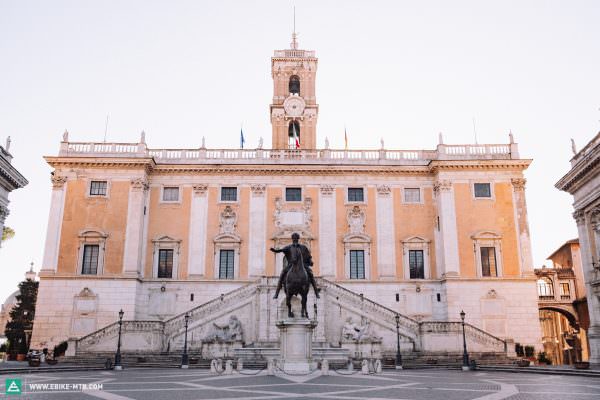
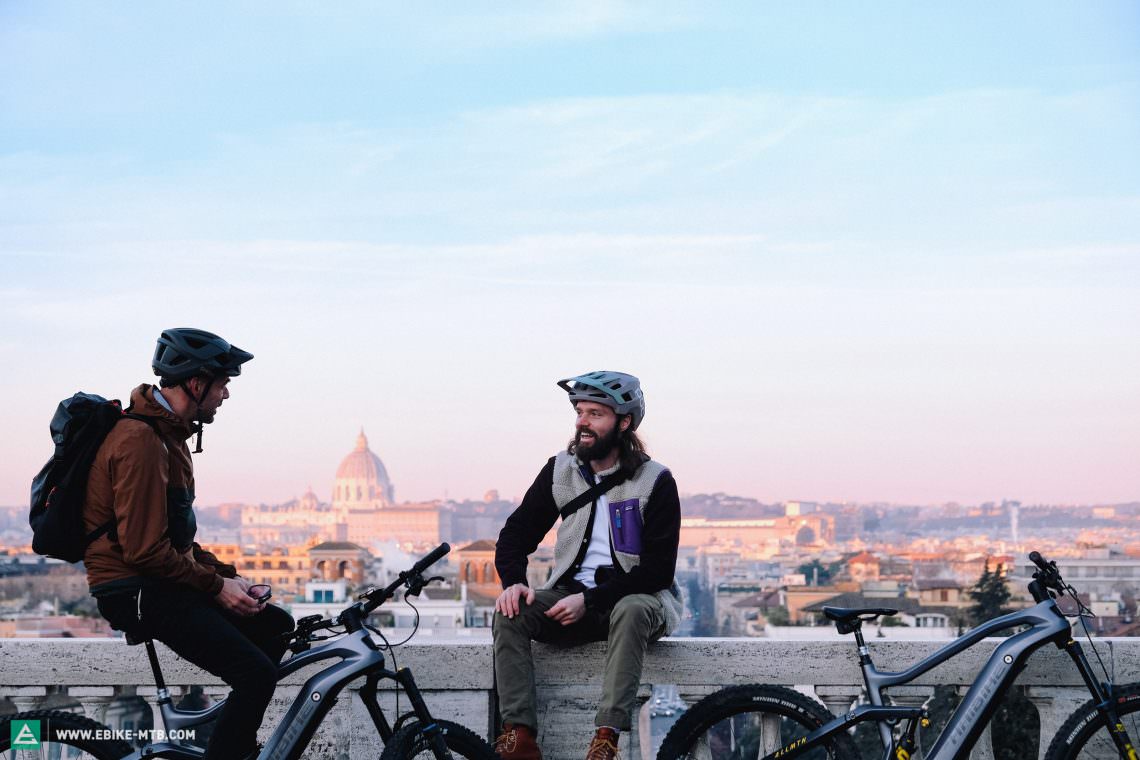
1. „Roma non basta una vita“ – A lifetime isn’t enough to experience Rome
There aren’t many cities that can compete culturally or architecturally with Rome and its 3,000 plus years of history. But does its stronghold on the past mean that the city doesn’t have a future? In search of the answer, we took lessons from Caesar and met the Pope, gorged on Roman cuisine and hit some antiquated rocks on Tivoli’s trails.
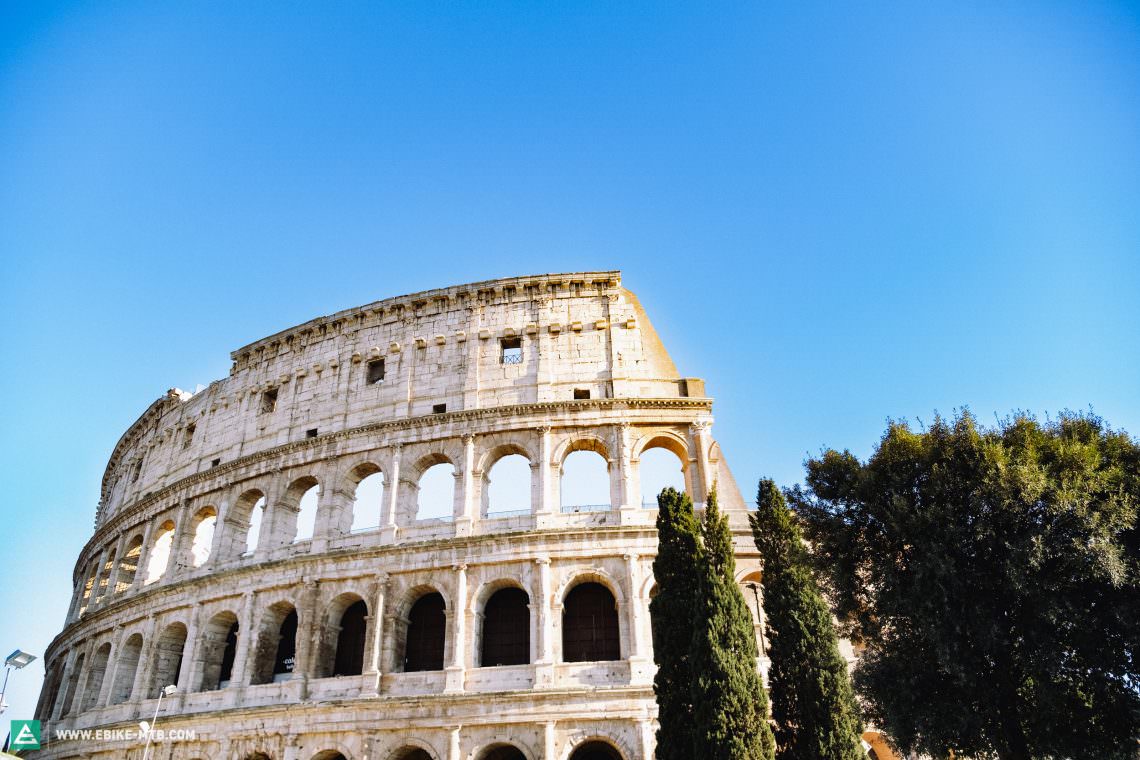
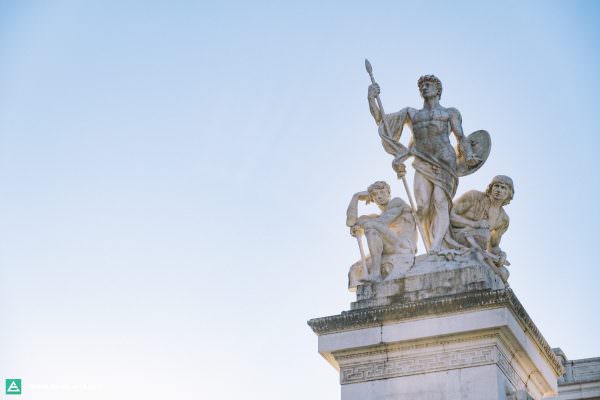
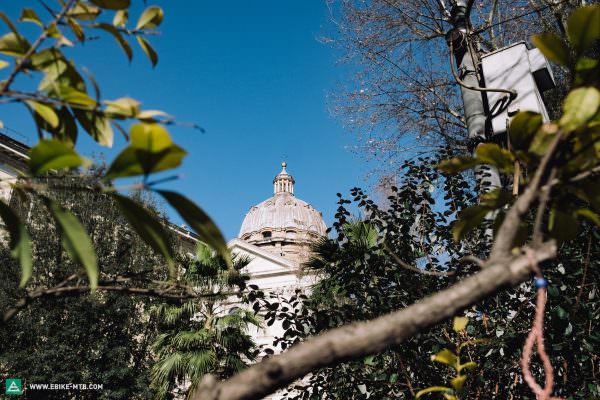
Once the political, social and cultural hub of the west, even at a distance of millennia, Rome still eats out on accounts of its long-lasting empire, historical exploits, breathtaking spectacles, Gods and wild orgies. Ancient Rome has had probably the biggest impact on how we live today – they’re basically a version of ourselves. Unconvinced? They were expert engineers and built the first aqueducts in concrete as early as 300 years before Christ and some of these, while admittedly restored, still function for Rome’s water supply. Then there’s the influence they had on language – yours, ours, almost half of the words in English, and many well-used ones in German, as they’re all part of the Latin family and shape how we understand the world. The Roman alphabet – the most widespread of all – was created in ancient Rome and spread to the rest of the world. What’s more, the Romans pioneered journalism with the Acta Diurna, a daily report carved on stone or metal that informed and involved the population in decisions, introduced subsidised groceries (particularly grains), education and clothing. Even the existence of motorways and roads, including the concept of congestion, goes back to ancient Rome.
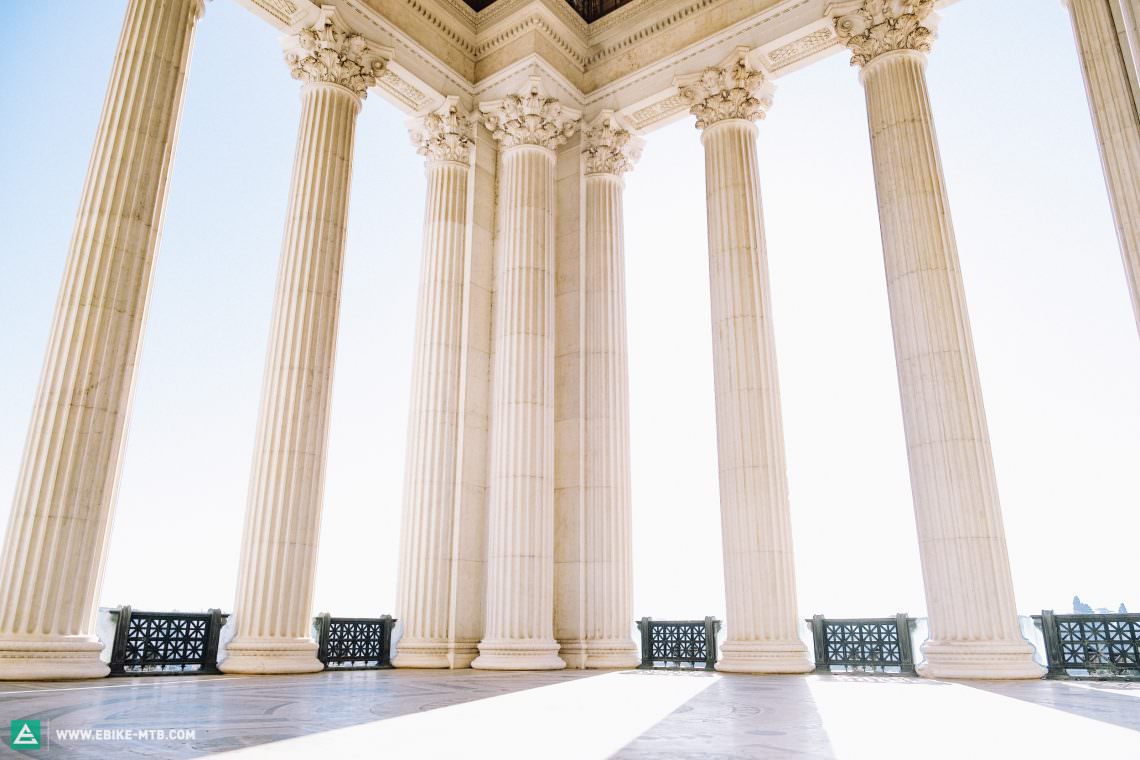
Riding through the Italian capital is like travelling into the past that can still be very much seen today. But on its way to the present-day, what went amiss in the story of this exciting city with its heady zest for life and invention? The heroized version of ancient Rome that was multicultural, progressive and capable of setting standards in so many facets of life, is one you only encounter these days in history books and guided tours, which ends up making today’s version of Rome almost seem old-fashioned.
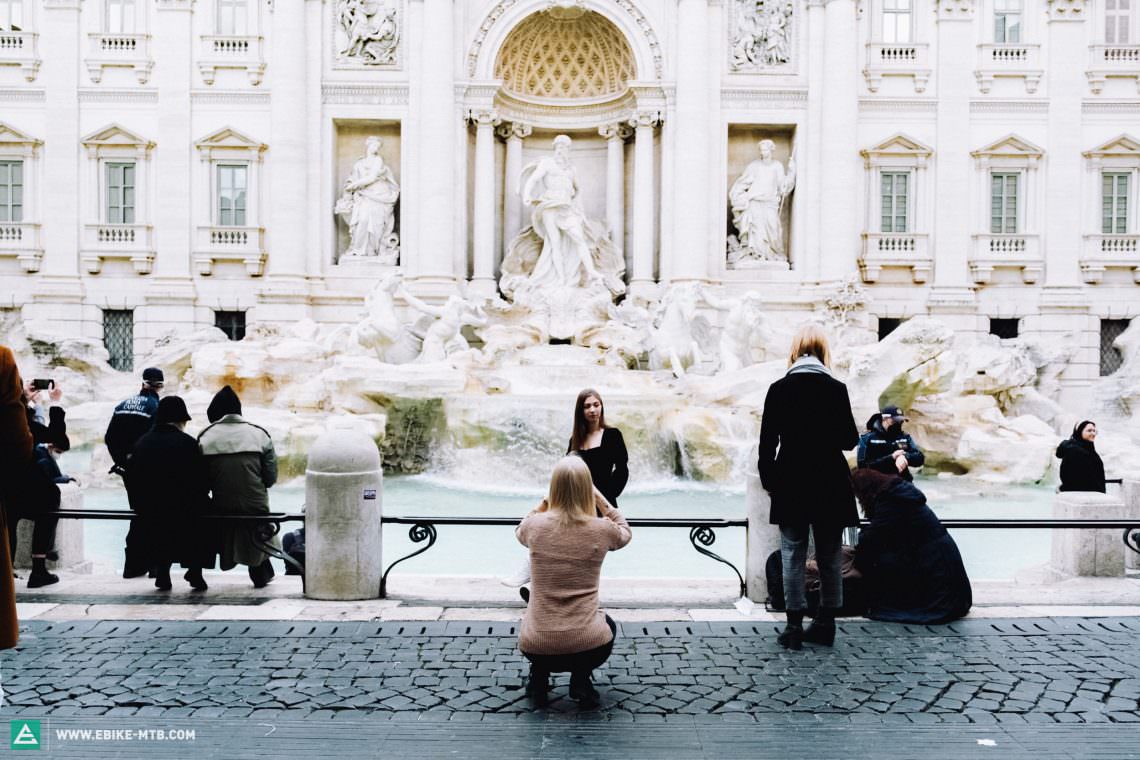
The truth is that despite the blood spilled during the building of Rome – the slavery, exploitation and brutal imperialism that aren’t up for debate – the ancient Roman’s societal sophistication and philosophies that have stood for over 2,000 years are nothing short of admirable.
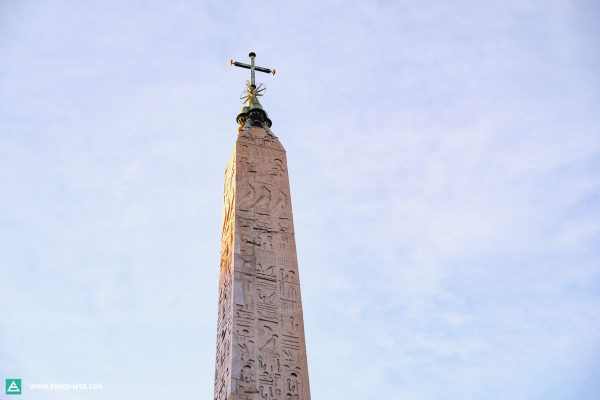

Tourists throw more than 1 million euros over their shoulder for good luck.
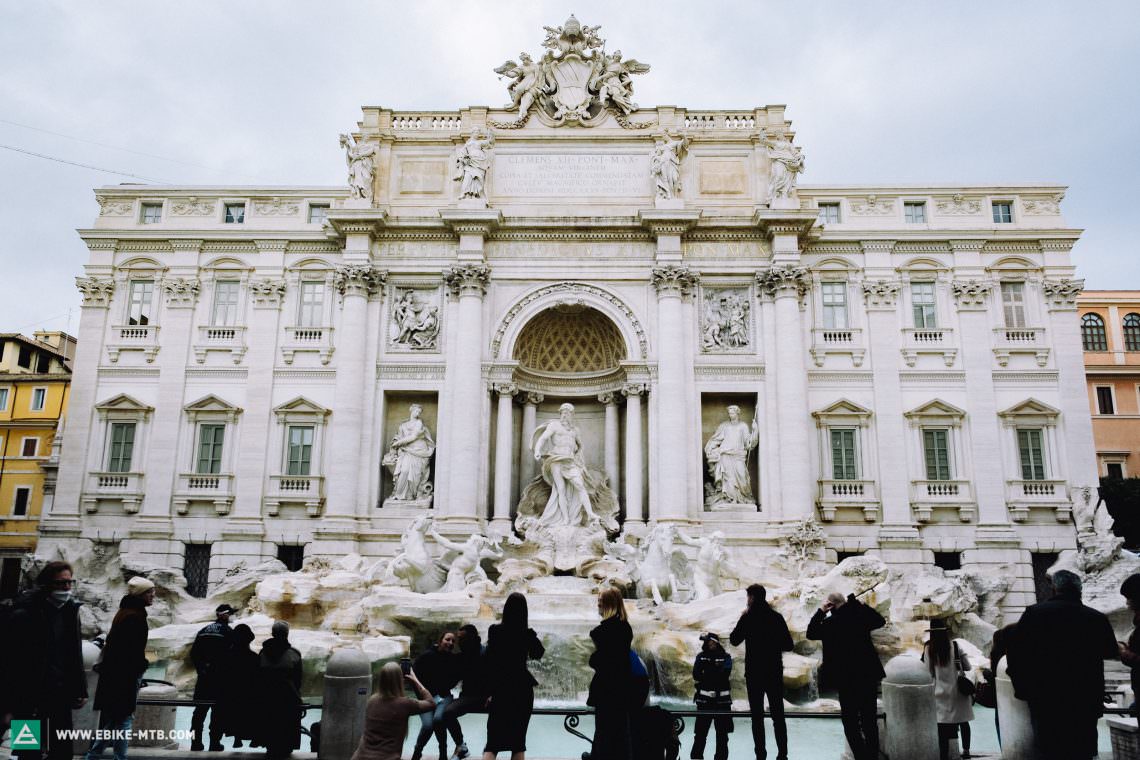
People used to flock to the centre of this cosmopolitan city for spectacular gladiator duels, staged naval battles and wild races, but today it’s mostly for a plate of cacio e pepe, a selfie with the Pope and the remnants of the glory days. But despite all its pomp and circumstance and the fact that Rome’s golden age appears to be over, the city still sparkles in the evening sun like no other. Is it just because of the shimmering gold coins that tourists chuck into the Trevi Fountain?
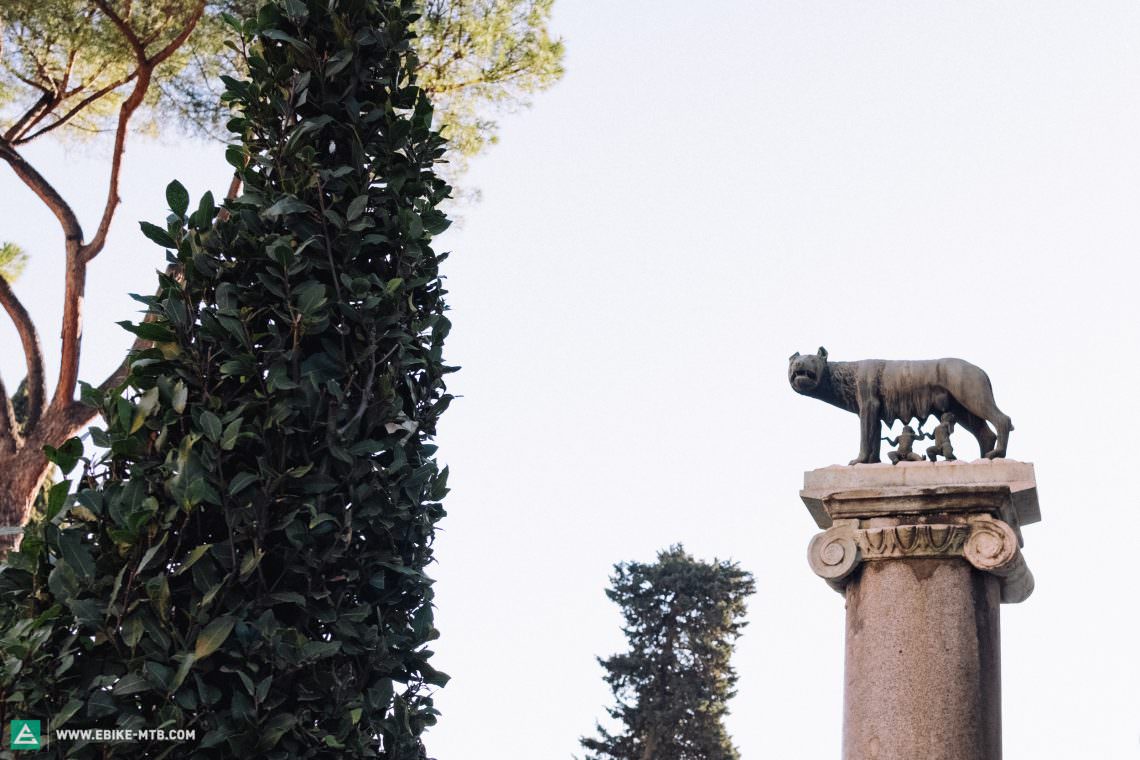
Unlike other capitals, Rome isn’t the place for frothy oat milk flat whites, Macbooks, fast food and hip co-working spaces. The reasons are two-fold: firstly, it’s Italian; and secondly, for better or worse, it spins on a historical axis that is flexed furiously as its Unique Selling Proposition. Without tourism, Rome would have a hard time surviving. It has more than 10 million visitors annually and ranks fourth on the hottest destinations in Europe. Most people come to gorge on history and end up leaving with full stomachs and full memory cards to boot.

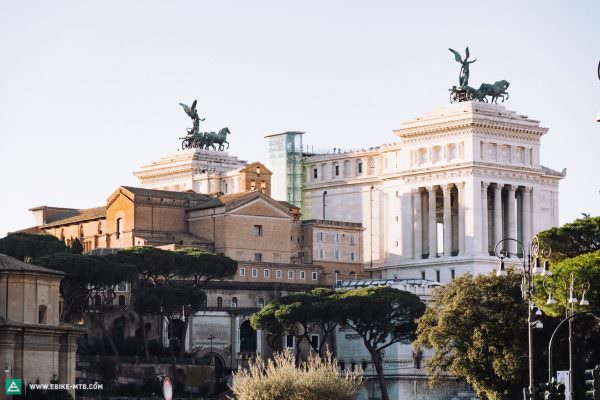
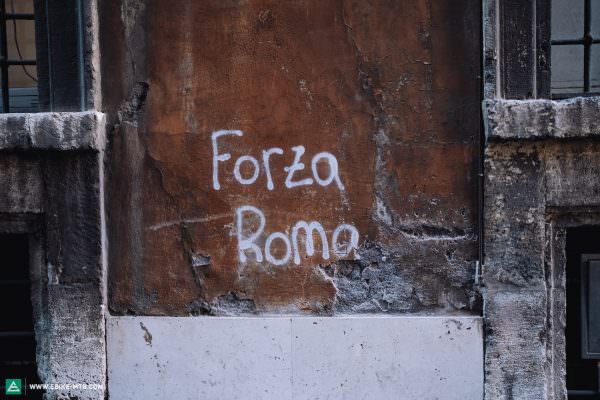
Being a tourism powerhouse often has pitfalls, like ‘selling out’ or gentrification – something which is most evident in the trendy district of Monti. As tourism strangles the city even more with big business, pavement cafés scramble for space and flashy signs try to grab your attention in a consumer-driven craze. The phenomenon that Barcelona went through with wealthy foreign investors laying claim to the property market for Airbnb is happening in Rome right now, and there’s a fear that long-standing businesses don’t have much of a chance against more lucrative ventures.
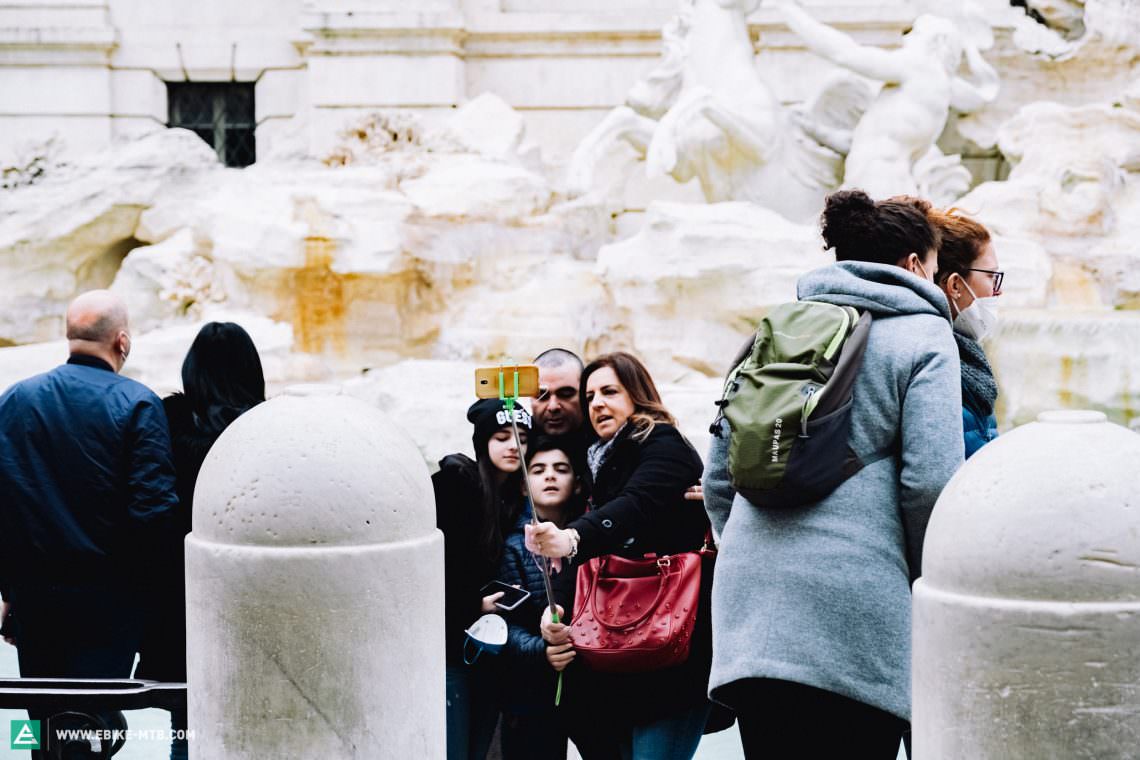
Then there’s Rome’s status as the world-leading economy and trade nation. Well, that didn’t last long: up until today, the city hasn’t really been able to establish an international competitive industry, other than fashion. With close to 3,000,000 residents spread over 22 districts, the Italian capital relies on its reputation for art and culture and is home to big fashion houses like Valentino and Fendi.
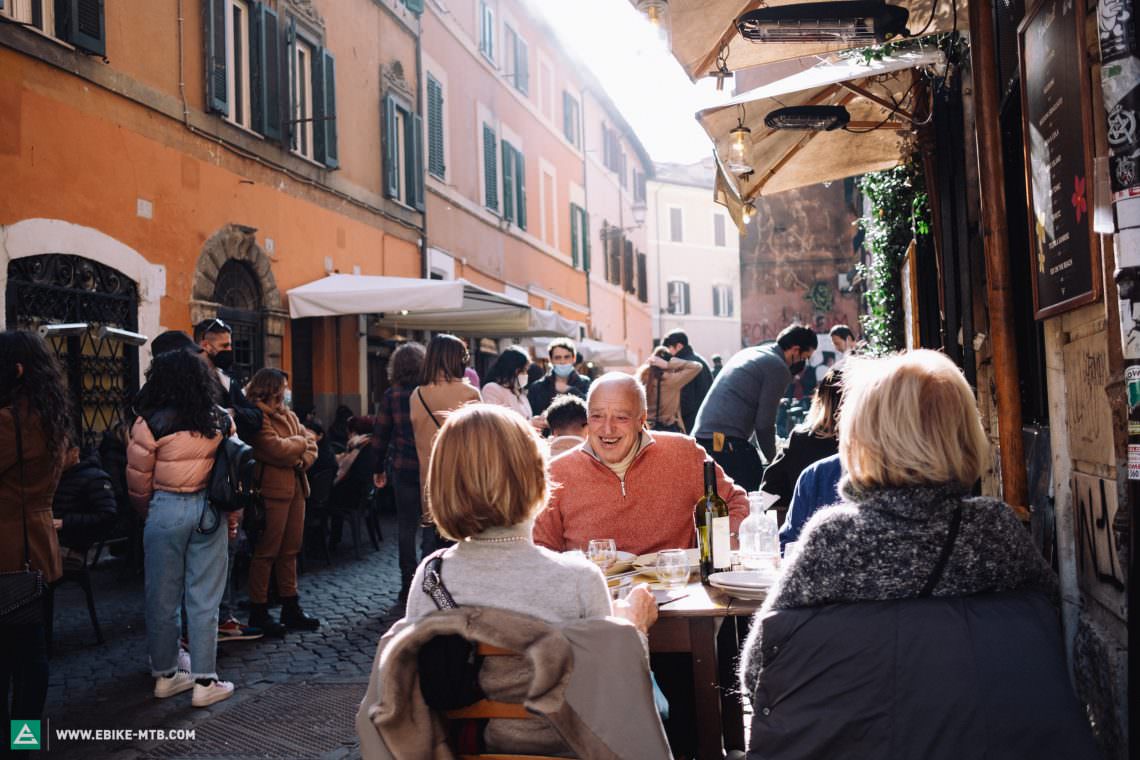
As you’re perhaps reading between the lines, Rome clings to the ‘why change a winning team’ approach, seeing it play all its cards in the field of tourism. And it pays off: there’s no doubt you’re seeing an original. But we get the sense there’s something missing, like the avant-garde and cosmopolitan elements that we appreciate so much in other capitals.
Even with arguably brilliant universities, a great location and a decent size, Rome hasn’t managed to draw in a younger crowd – yet. As a city, it’s more the preserve of politicians, lovers of arts and culture, and those into religion. You’d look in vain for Rome’s once hip and forward-thinking spirit. Its two underground metros heave and there are reportedly only 21 taxis per 10,000 residents. We learn there’s a crippling fear rampant in Rome: when it comes to doing or building something new, you’re bound to stumble over some archaeological ruins.
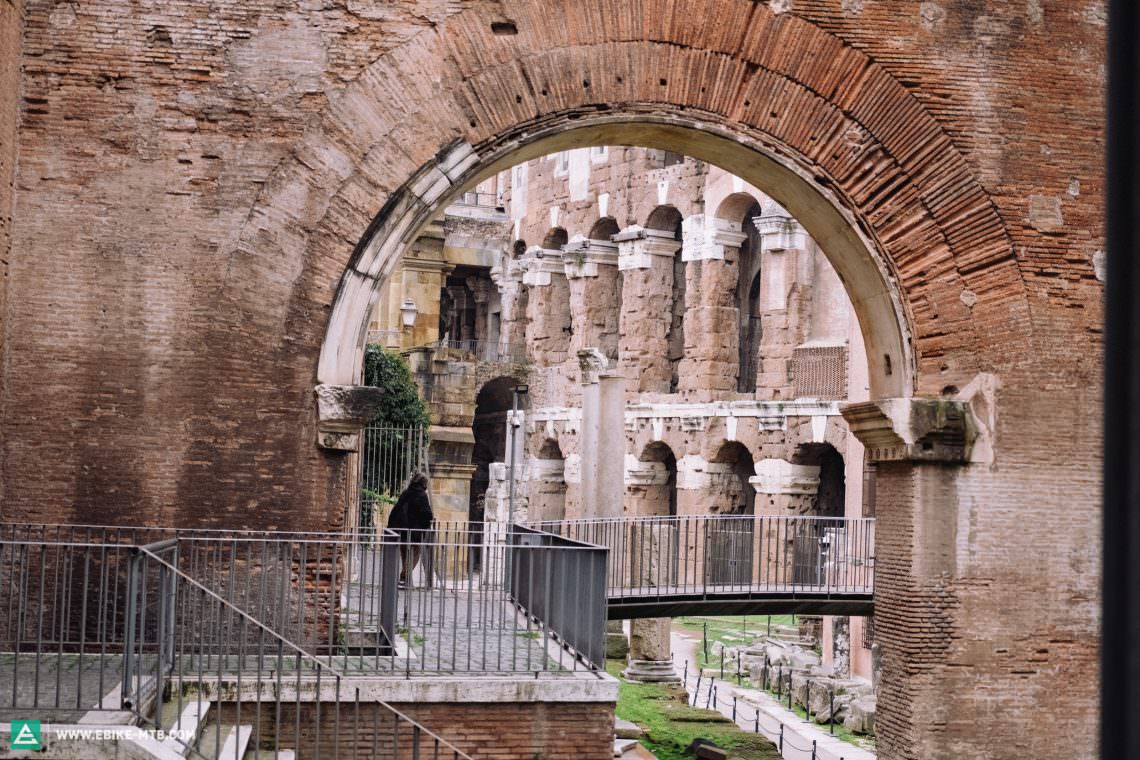
There are only two metro lines in Rome because each time construction work begins, you’re almost guaranteed to land on something of historical importance. That brings the end to the construction and eventually everything gets packed away.
From a myth to a world power
In various corners of the city, you’ll find the cast-iron landmark depicting the main characters in Rome’s foundation myth: the demigods Romulus and Remus suckling on their mother, a she-wolf. Legend has it that Romulus founded Rome in 753 BC after killing his brother over an argument about the city walls. Believed to be the sons of Mars (the god of war) and a priestess, the brothers were allegedly abandoned in the River Tiber and raised by the she-wolf and a woodpecker. The fact that the Latin word for she-wolf – lupa – can also refer to a prostitute is often absent in history books. There’s a less dramatic creation story that seems more plausible, which goes like this: two and half millennia ago, a collection of small villages on the banks of the Tiber formed a city, whose influence spread across the Mediterranean and even as far away as the British Isles. It reads like a success story that marries well-executed military campaigns and conquests with the art of politically unifying far-away provinces. Back when Christ was born, Rome already counted one million inhabitants and by the second century had expanded to three continents with a population of 50 million. Talk about a boom!
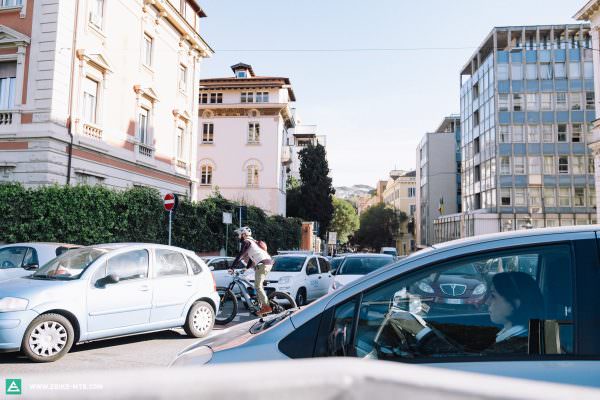
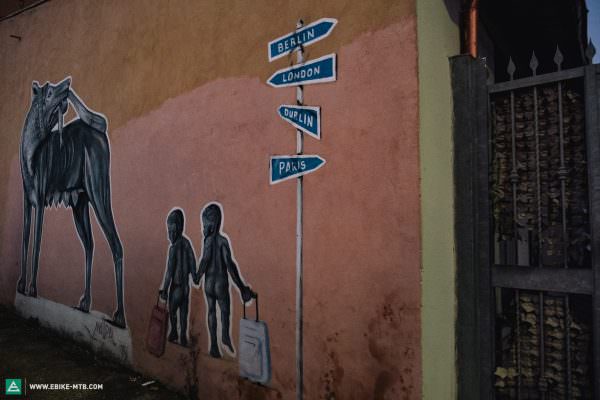
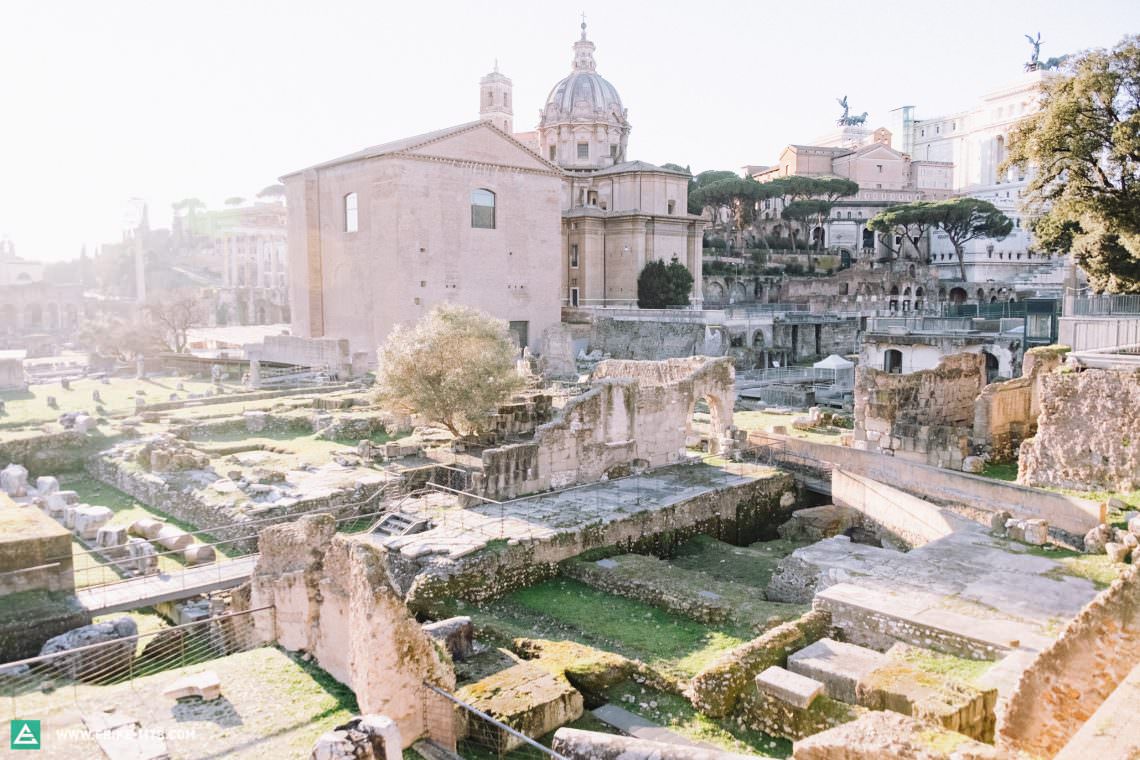
This introduction may sound harsh on the Italian capital, but it’s like any visit to your grandparents: there are highs and lows. In search of an answer as to what a visit to the Eternal City entails, we left no stone unturned as we sought to see the true appeal of Rome. Keep reading for the ultimate guide on where to dig up its intoxicating energy.
2. Tempus fugit How to compress 2,775 years into a day
One thing we can all agree on is that to truly explore a city – and that means going beyond a tick list of tourist sites – you need to hop on a bike. Away from the mythical sanctuaries and palaces, it’s in the saddle, riding next to locals, that you’ll get to know the true side of Rome.
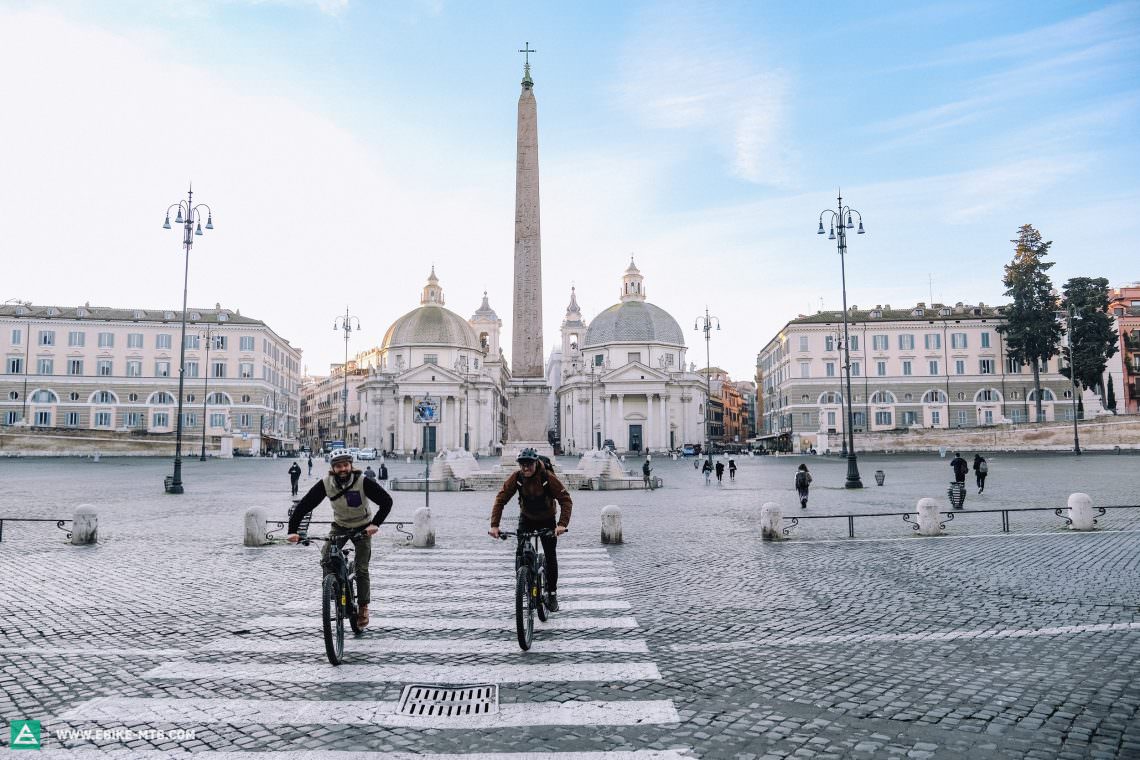
Rome is big, verging on overwhelming. It’s not clean like Copenhagen. It’s messier, a bit chaotic, a bit grubby, but no less impressive. The Trevi Fountain, the Spanish Steps, the Vatican. We’ve all seen them, but did you expect horses and goats to roam around the city and more green spaces than in any other capital? It’s true: 67% of its surface area is green, giving each resident 166 square metres of free space each (if they didn’t live in flats, of course). That greenery serves riders well, too, and it’s fair to say that trail riders are well catered for across Rome’s seven hills.
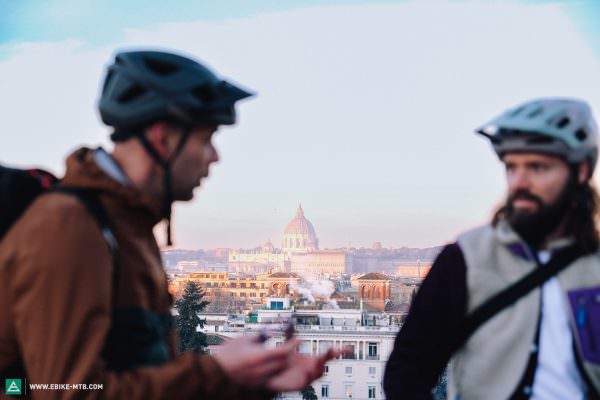
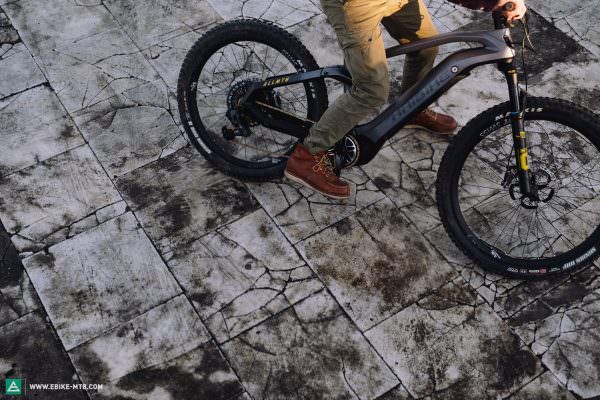
Having signed up for the task of showing us around, Alberto Martinelli, who has lived in Rome for over 25 years, proved better than any guidebook. Alberto is in the process of setting up an ebike rental and guiding business, so we volunteered to be his first guests. With a contagious energy and sense of adventure, we weren’t surprised when the well-spoken, deeply knowledgeable rider whipped out an itinerary promising the best of Rome’s hidden gems alongside the obligatory history spots. We were stoked. Dai, Andiamo.
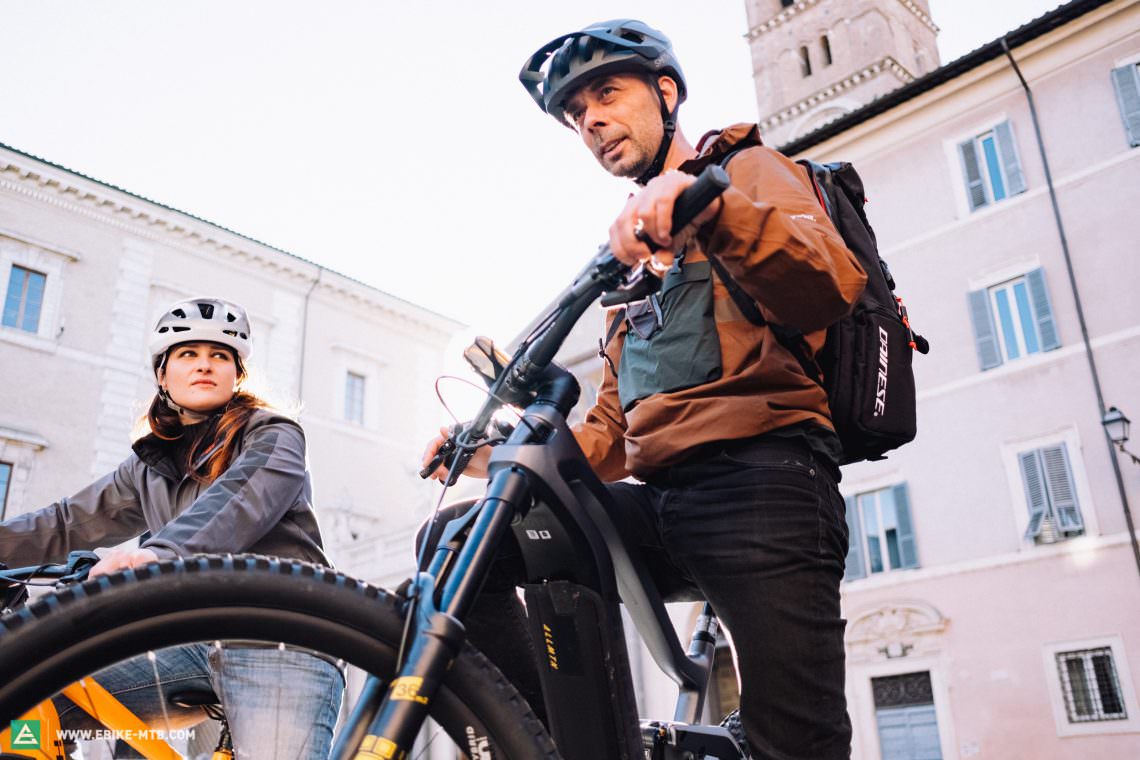
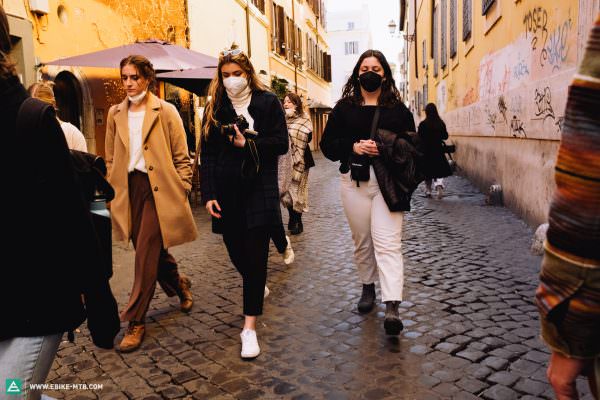
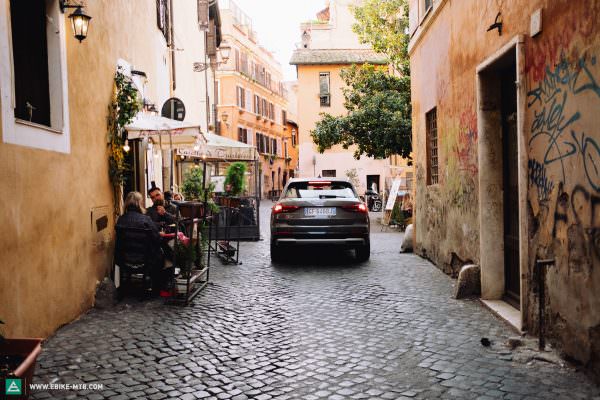
See you on the other side!
We arrange to meet Alberto in Trastevere, which means on the other side of the Tiber. A vibrant district (with a high density of grumpy teenagers trailing after enthusiastic parents), these tightly knitted alleyways are where once the labourers, immigrants and fishermen’s families lived – a subsection of society that went largely ignored after the Romans came into power. It spawned a subculture that has left its mark on the architecture, distinguishing this district that’s lovingly referred to as ‘the village in the city’ from others with its little cafés, restaurants, students and creatives. Al fresco dining and outdoor aperitivos are the order of the day. Above our heads, laundry is hung out to dry, while the soundscape is pierced by Vespas whining through the little lanes and the shrieks of Italian gulls overhead.

Tooting your car horn in Italy can mean a multitude of things. It could be more of a question: ‘hey, what’s going on up there’ or ‘watch out, coming through!’ or ‘**** you, you ****head
From Trastevere’s romantic cobbled alleys, we weave into the traffic, which manages to squeeze four lanes-worth into just two. We ride towards the centre of Rome in a manner that’s best described as threading a needle through gaps. Second stop is the former Roman Ghetto, established in 1555 to house Rome’s Jewish population and still home to the biggest synagogue in Europe. Stars of David adorn the crumbling walls of a few houses, restaurants, and bakeries. We grab a snack and cruise through the ruins of the Marcellus Theatre and the Temple of Apollo, which was built in his honour after he allegedly rid the city of a plague that was sweeping across it. Speaking of plagues, do you think Apollo could be the guy for the Corona? Anyone got him on speedial?
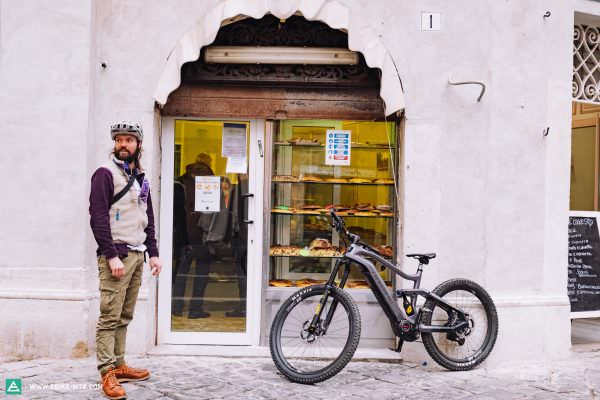
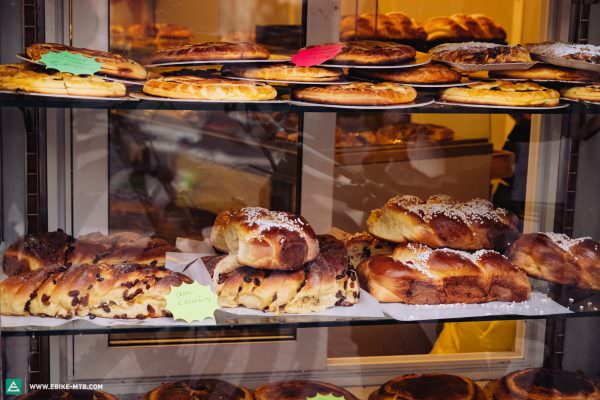
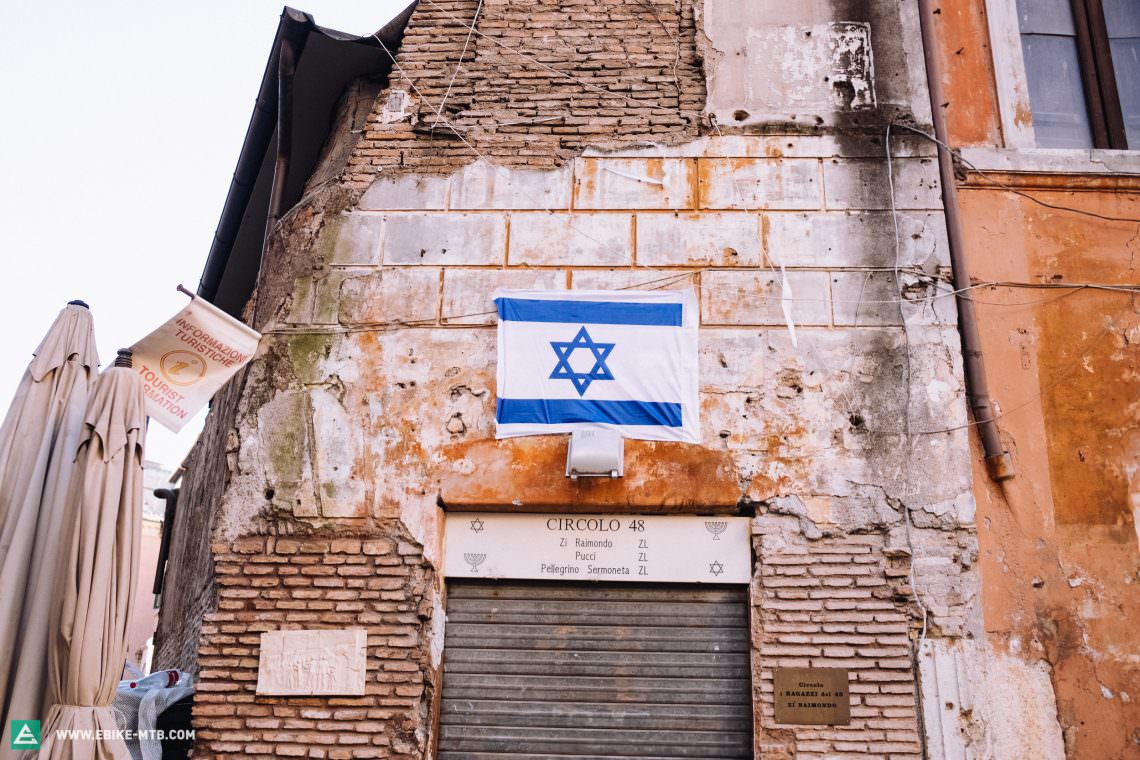
The purr of our ebikes is suddenly interrupted by yells: ‘Wow, wow wow’ and ‘Mate!’. The reason: the Victor Emmanuel monument has just come into sight between the buildings. It’s the symbol of the Italian Republic, and basically the altar for the entire country. It leaves us speechless. Mutely, we circle the monument, picturing a young Julius Caesar on this very marble, dressed in a bathing robe, slurping from a mug that reads ‘I’m the Boss’. Our imagination, we’re informed by Alberto, is a few centuries off: it wasn’t built until 1911, which meant there was no chance for Caesar to rub sleep out of his eyes here. Oh well, that explains why the building is in such good condition.

The world’s biggest open-air museum
Significant ancient monuments and memorials are routine in Rome, and there are only a nominal number of things that weren’t painted by a certain Michelangelo or designed by Nicola Salvi. Every house, stairwell, even roof tile, appears to have played a role in Rome’s history and therefore lends itself to paying homage to some ruler or other. And with good reason: every single important ruler in Rome has endeavoured to immortalise themselves in the cityscape. Romans, we discover, had a different relationship with architecture and buildings than we have today, where the focus is more user- or purpose-orientated. Back then, it was an art form, deployed as a way to celebrate victories, give a gift, or out of simple hedonism – and by that, we refer your gaze to lavish arches, absurdly large thermal baths, obelisks, and mind bogglingly intricate designs. Even with today’s advanced technology, is it even possible to emulate the richness of detailing that went into these impeccably fashioned ancient buildings? Just look at the Pantheon, for example, one of the best-preserved buildings from antiquity.

Rome builds on its history. Literally: Mussolini inadvertently excavated the Imperial Forums (in his words ‘liberating’ Roman antiquities) by bulldozing the Via dei Fori Imperiali to create his dream boulevard for pompous parades that went straight from his balcony to the Colosseum. The example of the fascist Il Duce is not an uncommon one in terms of town planning for Rome, which has often repurposed its history to shape something new – especially in terms of architecture, where building materials from ancient ruins have found a new home elsewhere. St Peters and the renaissance Palazzo Farnese, where bullfights and festivals used to take place, contain stones from the Colosseum, while ancient marble statues were repurposed for Baroque buildings, and the Pantheon’s bronze panelling was melted down to become a lavish baldacchino at the St. Peter’s Basilica.

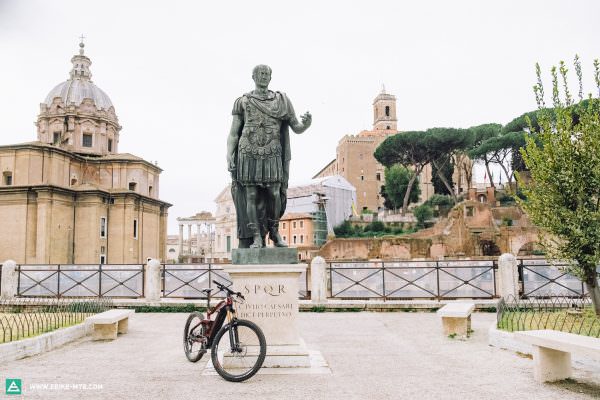
Our jaw stays permanently dropped in awe as we ride down the Via dei Fori Imperiali past the ruins of the Imperial Forums to the gigantic Colosseum. These days it’s very shabby-chic, but it’s not hard to picture the pomp of the past 2,000 years.
It’s at about this moment that we bump into the man himself, Julius Caesar on his Haibike AllMtn 12, who immediately catches the attention of nearby police officers. It must be his blatant disregard for wearing a helmet. We invite him for a chat in our hotel lobby that same evening, and he points us wordlessly in the direction of the Vatican.
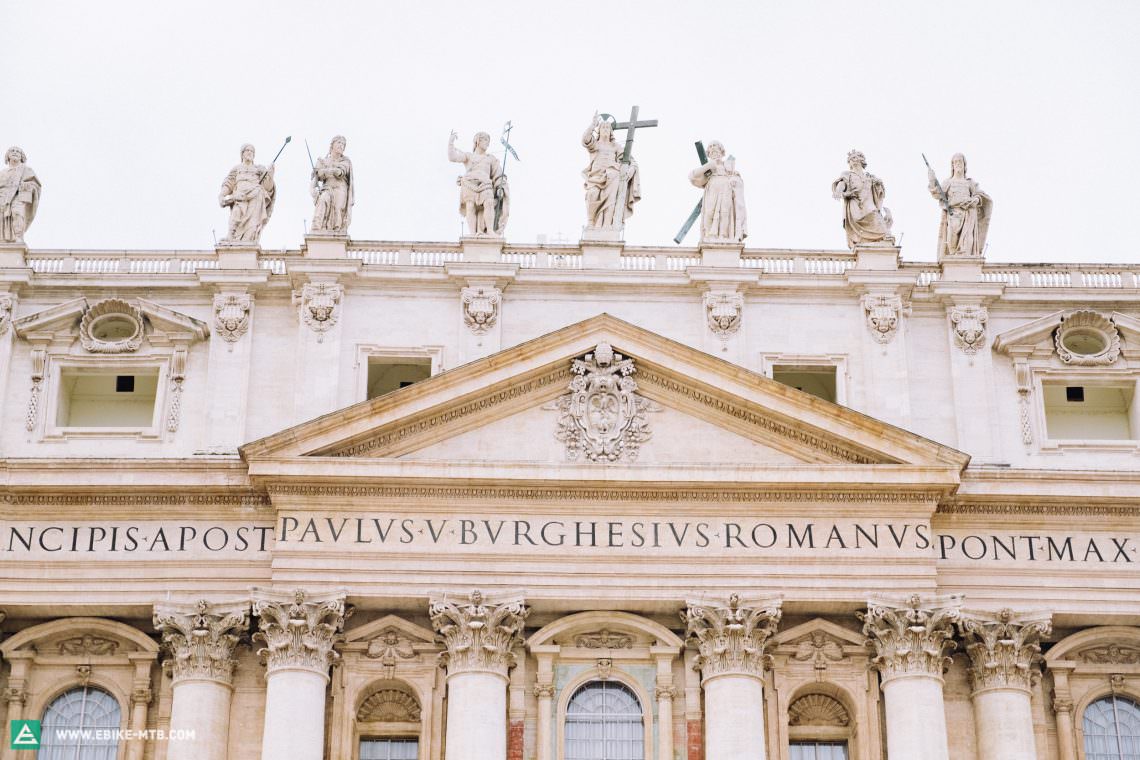
If the Pope is your cousin, are you destined to become a Cardinal?
On a short detour into the heart of Christian faith, we pedal through the world’s smallest country in the middle of a capital city. The Vatican is a place of a higher order, even higher than other nations maybe. Just 44 hectares in size, the influence wielded by one of the oldest institutions in the world is often underestimated. Presidents and heads of state collect their blessings here after taking office, and the Vatican even has observer status within the UN. We ring the bell several times, but the Pope doesn’t appear. He’d have enjoyed a spin on our Haibikes; they even had half a battery left. Divine sensations, guaranteed!

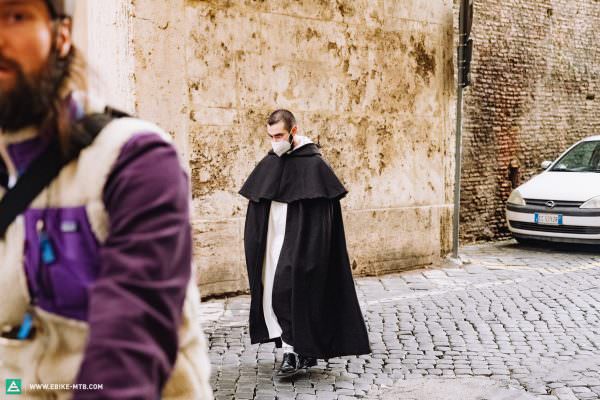
It doesn’t get any greener than Rome!
As we meander through the city, we note the number of parks and green spaces in Rome, including huge fields where dogs are going wild, groups of children picnicking and celebrating, and gatherings of outdoor yoga. Space is clearly a luxury that Rome’s residents relish. When we do a lap of the Park Villa Borghese with its 17th-century gardens, we know where you’d find us if we were here on the daily.
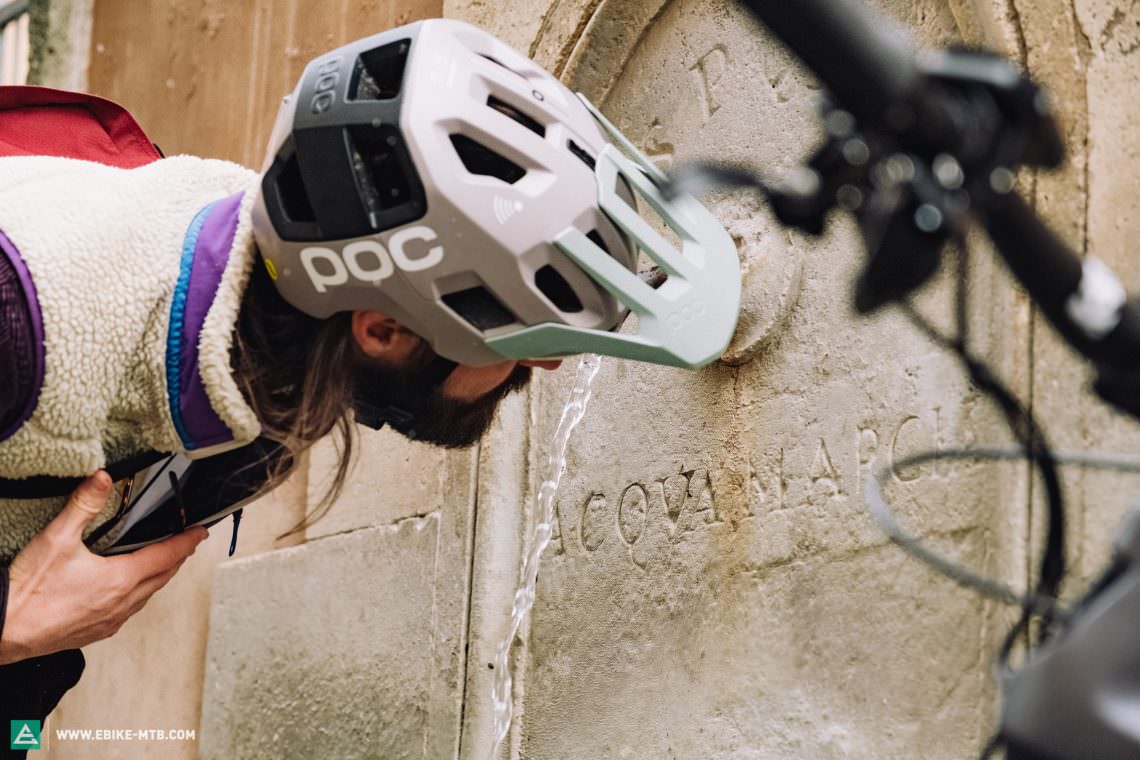


The Italian capital is making inroads into becoming a bike-friendly city and redesigning the layout of a few roads. It’s a slow process, but the Corona virus helped speed it up: during the peak of the pandemic, the city added almost 200 km of bike paths into its existing road infrastructure – it includes some marked bike lanes that finish in dead-ends, but also others that are new, impeccably designed and segregated from cars to keep cyclists safe as they cross the city. There’s another 45 km in the pipeline, which will loop around the centre of the city as part of an EU-subsidized project called GRAB. This will incorporate broken roads, which go back to the era of Ancient Rome, green spaces, the Baths of Caracalla, horses that roam freely and a few of those still functioning aqueducts, which stand with a passive dominance above the runners, joggers and leisure-seekers that want to escape the city for a moment.
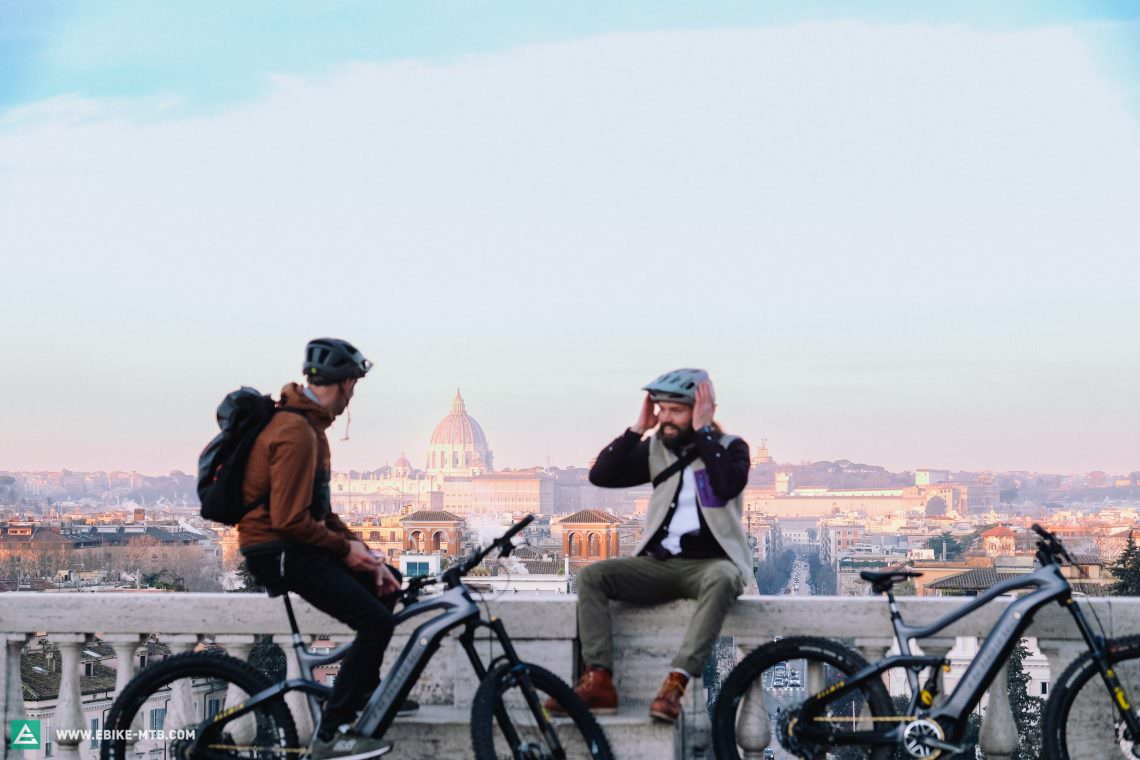
For one of the best views over Rome, head to the Terrazza del Pincio. Come here early to avoid the crowds.

By the time the sun dips lower in the sky, our legs are as empty as the batteries on the Haibikes. We order our first red wine in a small restaurant on the edge of the city. Having hastened through the history of the Eternal City in turbo mode, we had fallen in love with its crumbling, charismatic and somewhat frenzied identity. And while Rome isn’t truly cosmopolitan in 2022’s western understanding of the word, that’s probably the reason we are even more excited about a plateful of traditional, tasty food in a tavern.
3. A fictional interview about orgies, Rome and ebikes with the city’s arguably most famous resident ever
Submitting an official interview request would have taken too long, but we grabbed the opportunity when it arose to catch some words with Gaius Julius Caesar about modern day Rome, the misinterpretation of orgies, eMTBing, and his relationship with Asterix and Obelix.
Caesar, where do you go to kick back in the evenings? – I should begin by saying how Rome has changed more than you’d have expected in the past 2,000 years. The Roman Empire is no more, Rome is now just a part of Italy, and it’s definitely not a world leader anymore. All of the once great things like epic gladiator duels, elephants and naval battles have fallen out of fashion. It used to be a wild place. You never knew what topics of conversation would come up at the thermal baths or communal toilets. Life was different. We lived it with an intensity that’s rare nowadays. It could be because we were so acutely aware of our mortality – each time I’d be on my way to the consulate I’d have to walk over at least three corpses who’d surrendered to the Antonine Plague. We also had different values back then, like orgies – they were something sacred, just look at the etymology of the Greek word orgia. At times, it was an excessive act, but there was a sense of ecstasy in meeting new people and reaching a different state of consciousness.
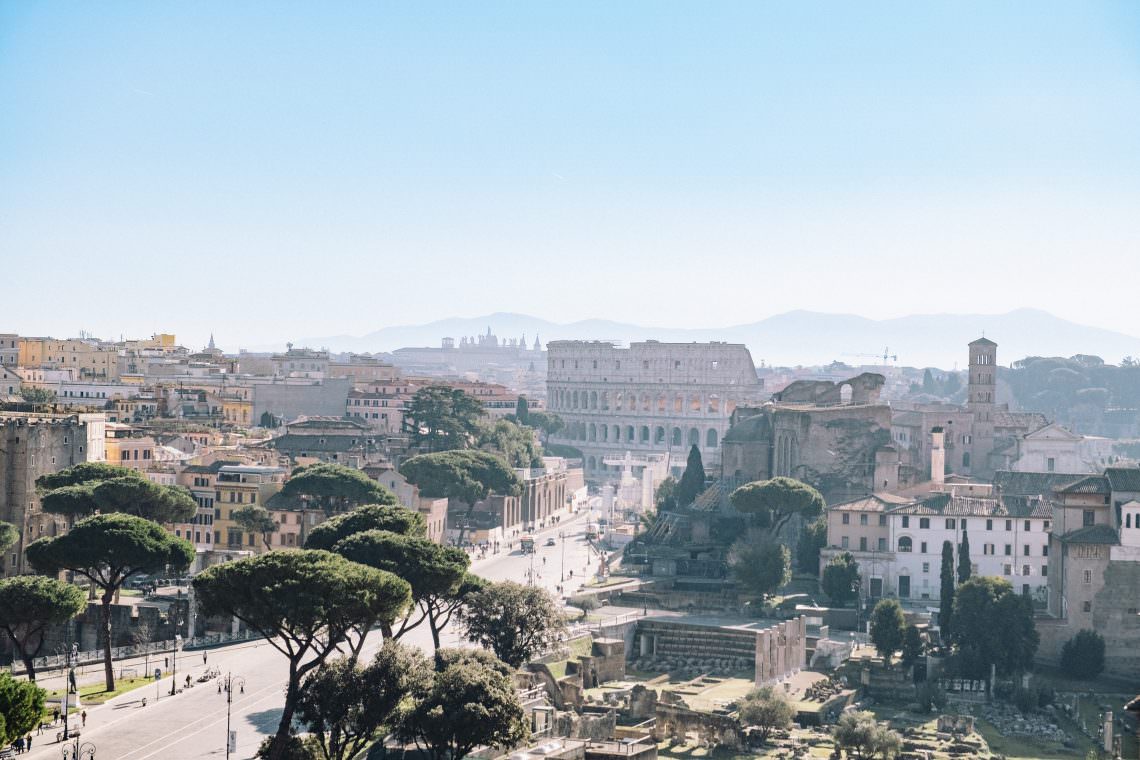
Caesar, what do you think of Rome today? – There’s a big part of me that’s thrilled at how our architectural heritage from 2,000 years ago is largely still standing. Perhaps if I’d taken the matches away from that old pyromaniac Nero, then there’d certainly be even more to see today. I’d like to see the Romans bring more of our heritage back to life, but I get the feeling that the conservative branch of the city and the church like to keep a firm hold on things. In my day, it was much more multicultural and progressive, whereas today’s Rome focuses on tradition and almost overlooks the art of being that is essential to life. So many millions of tourists march past me each year and stare at the ruins of our great buildings, but that’s only one part of our story. Our existence isn’t based on statues and buildings; they were just part of the shell of our lives. We were the beating heart of the world – our architecture, culture and openness were on a level that basically no society has any hope of matching today.
Rome wasn’t just a city – it was more of an idea. We wanted to spread our knowledge all over the world and gather all the greatest elements right here. Rome thrived on cultural exchanges and curiosity. It was thirsty for new things. It was our incredible wealth of knowledge that created a gravitational pull and attracted the brightest minds in the world back then.


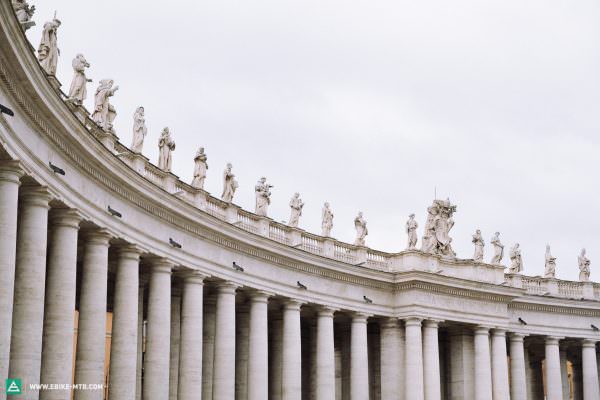
Veni vidi vici – once your mantra and now a common tattoo – do you have any advice for society today? – During my victory parades, I always had a servant in the chariot who’d whisper ‘memento mori’ in my ear. I needed to hear it: everything passes, everything dies. It’s like this – no matter how successful you are as a general or how great you are as a statesman – the end will come. The purpose of time is to teach us impermanence. It teaches us to seize the moment. Once you’re aware of your mortality, you can truly start to live, without making compromises or putting off your dreams and hopes. The first time I laid eyes on Cleopatra I went up to her directly. I didn’t entertain the thought of hesitating or wondering whether I’d meet her in my next life. Although that did come to pass. After my foster son killed me and I crossed Styx into the underworld like a dolphin, I was able to see her once more and I counted myself lucky that we’d already broken the ice.
I get the feeling that the Romans have forgotten how to evolve. Does the Eternal City not care about being the home of the zeitgeist any longer? Perhaps not. In order to stay at the top, you’ve got to keep at it. You can’t coast.
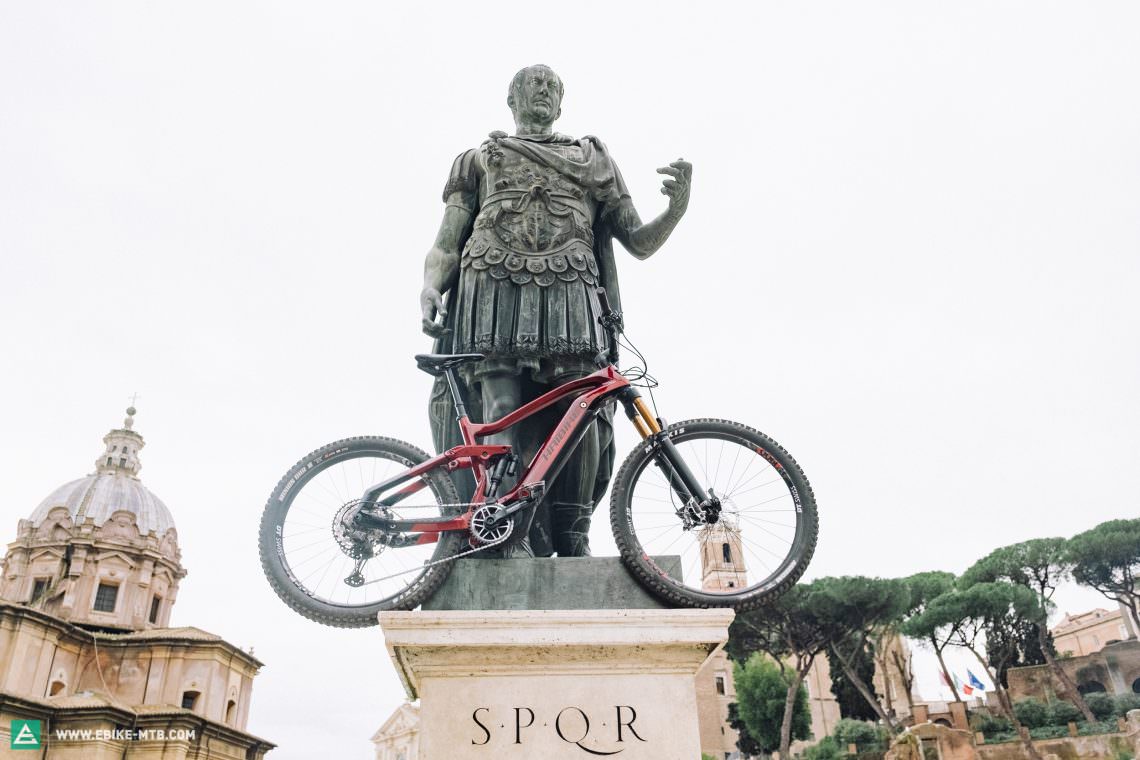
If you’d had an ebike back then, what would you have used it for? – I used to have pretty long commutes before I was a proper statesman. I was back and forth between the northern provinces of Illyria, Gallia Cis and Transalpine, so an ebike would have been a massive asset and probably a lot of fun. My family wasn’t wealthy, so I was very conscious about budgeting in order to finance my political career. Now that I’ve got the title of Caesar, I shouldn’t scrimp on style really. I’d have to have the bike in carbon, for sure. In fact, perhaps my next victory parade should be on an ebike rather than a chariot? Better yet, echariot! That’d stir up the crowds nicely.
The great thing about ebikes is their versatility. Like Cleopatra’s camels, they don’t need water either. I’d invite her on an e-ride around the Sphinx as I’m sure she’d love it. Bread and games were the backbone of the Empire and that’s where we and the people would get our adrenaline kicks. When I think about the rush you get from ebiking and imagine that spreading across the entire Roman Empire, it’s mind-blowing. I reckon we’d have built the world’s biggest trail network that’d outsize Whistler, Finale Ligure and co. ten times over!
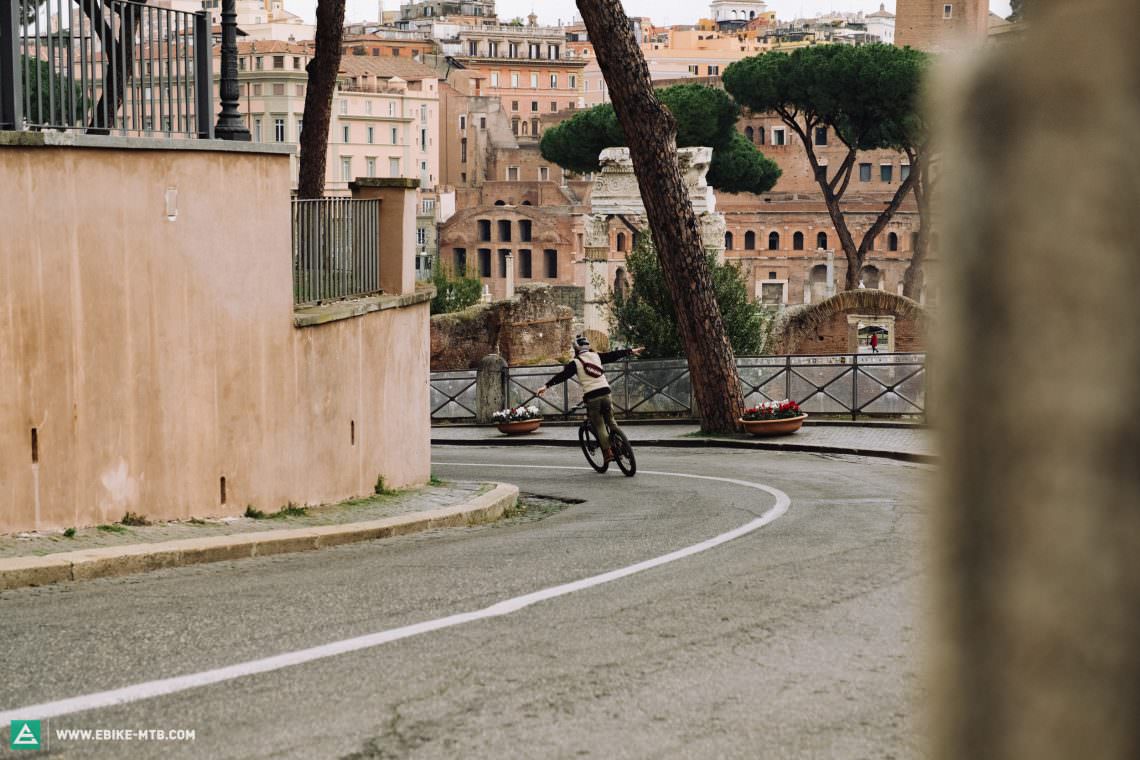
Bike-to-work schemes are massive, aren’t they? It took us 13 years to round up the army in the Roman Empire to its biggest formation, but if everyone had had ebikes, we could have done the whole thing in half the time. Of course, it would have depended on us having the charging infrastructure set up smoothly – not like Bosch, who decide to change the plugs from one model to the next. Imagine how jealous Asterix and Obelix would have been to see my army on rolling carbon stallions. Thinking aloud now, having eMTBs would have also solved a few supply issues – I remember what a nightmare we had last time we set up a spare parts store for our chariots. The wheel manufacturer raised the standard dimensions from 27.5″ to 29″, claiming that they rolled better over sand. Correct me if I’m wrong, but aren’t modern eMTBs a bit more loyal to their standards?
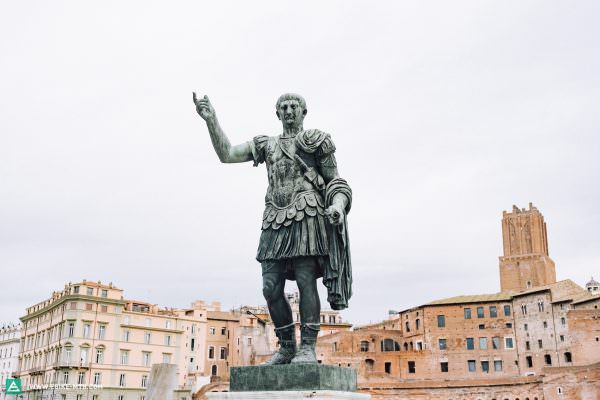
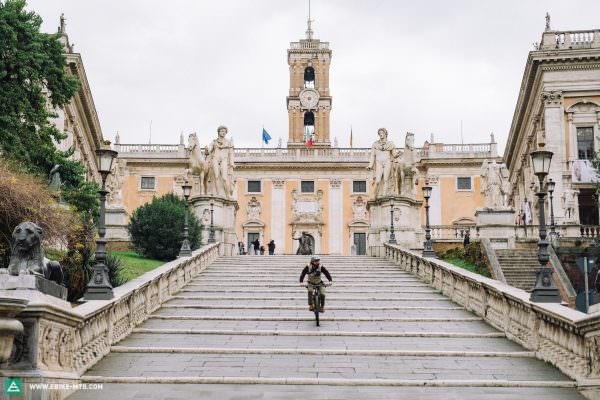
I’d certainly have loaned my bike to Brutus frequently as a way for him to clear his head. He’s been a bit out of sorts recently, constantly applying ointment to his nether regions and playing with a knife while I’m round at his mum’s place.
4. Mountain biking in Rome -Flow trails that trace Roman history
Other than the Pantheon, Pope and pasta, can Rome also deliver the pace and flow to satisfy a mountain biker? We rambled across Rome and its outlying regions with a crew of locals to explore the trail riding credentials left by the Roman ancestry.
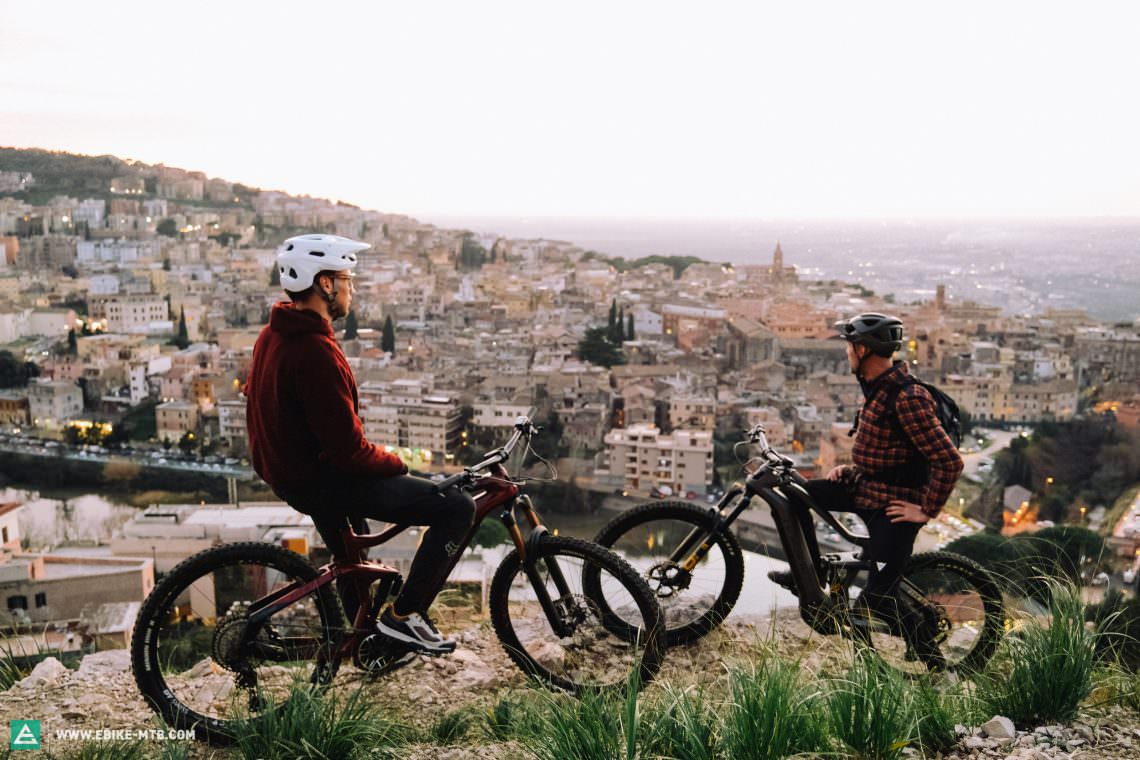
We make the obvious decision to do our first trail check in Tivoli, one of the most popular haunts for Rome’s bike riding community that sits on the Aniene River. Just 50 minutes outside the capital, it’s a firm favourite with locals, known for being the coolest spot in the summer with steep climbs, techy descents and uninterrupted views of the urban sprawl.


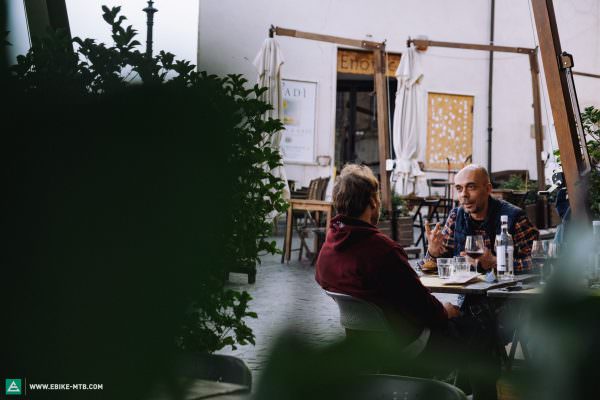
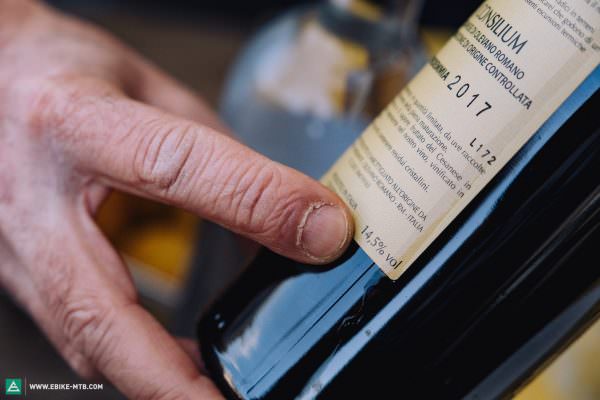
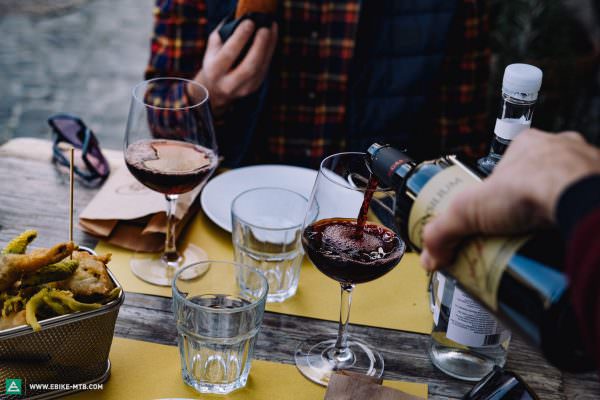
What’s the best pre-ride preparation in Rome? Probably not what you’d expect. Lasagne and red wine, so they say. We’re served such generous portions at lunch in the L’Ape 50 restaurant, that we reason our own consumption is basically as essential as charging the batteries on the bike. Alberto, our local contact and tour guide, hypes up the riding in Tivoli before we are even in the saddle, giving us the inside line on the trails – of which he assures us there are many.
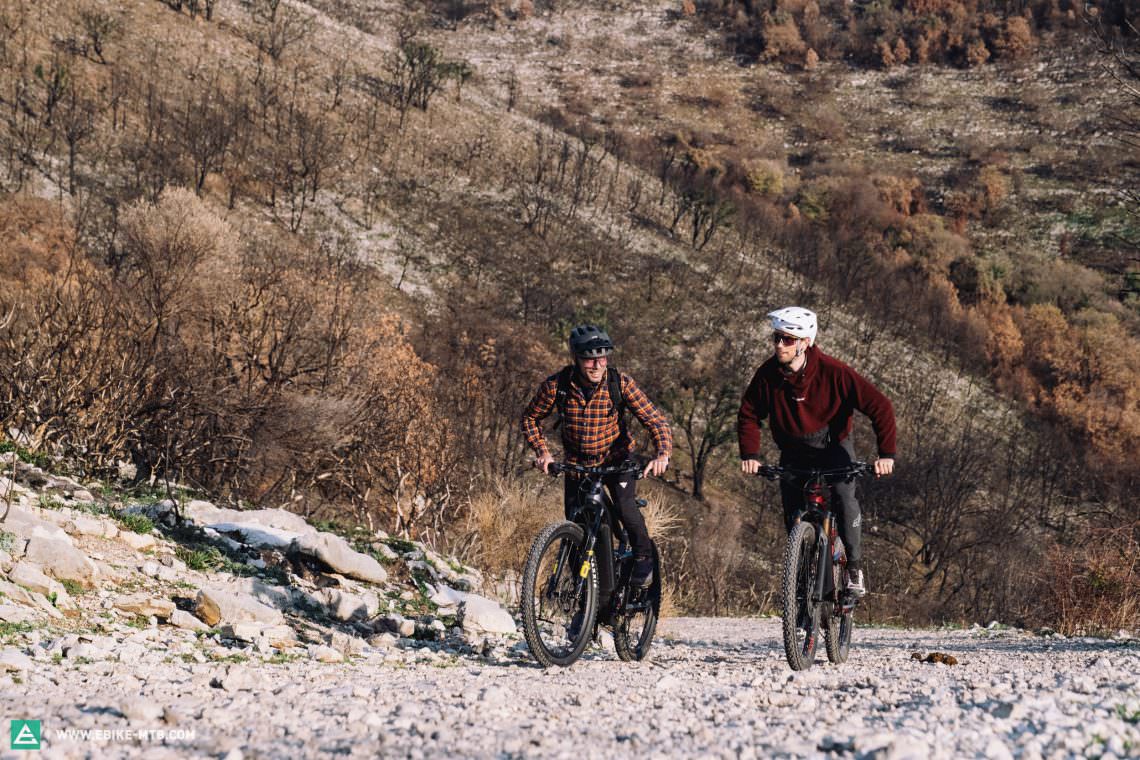
Let’s take it steep!
From the kooky little lanes of Tivoli, we set off with full stomachs towards the mountainside, feeling like the ancient Romans must have done after a feast. Already in the first few metres of the dirt track into the woods it dawns on us that eco mode won’t cut it today. Who said lasagne and wine was a good idea? Oh, that’s right: the locals.
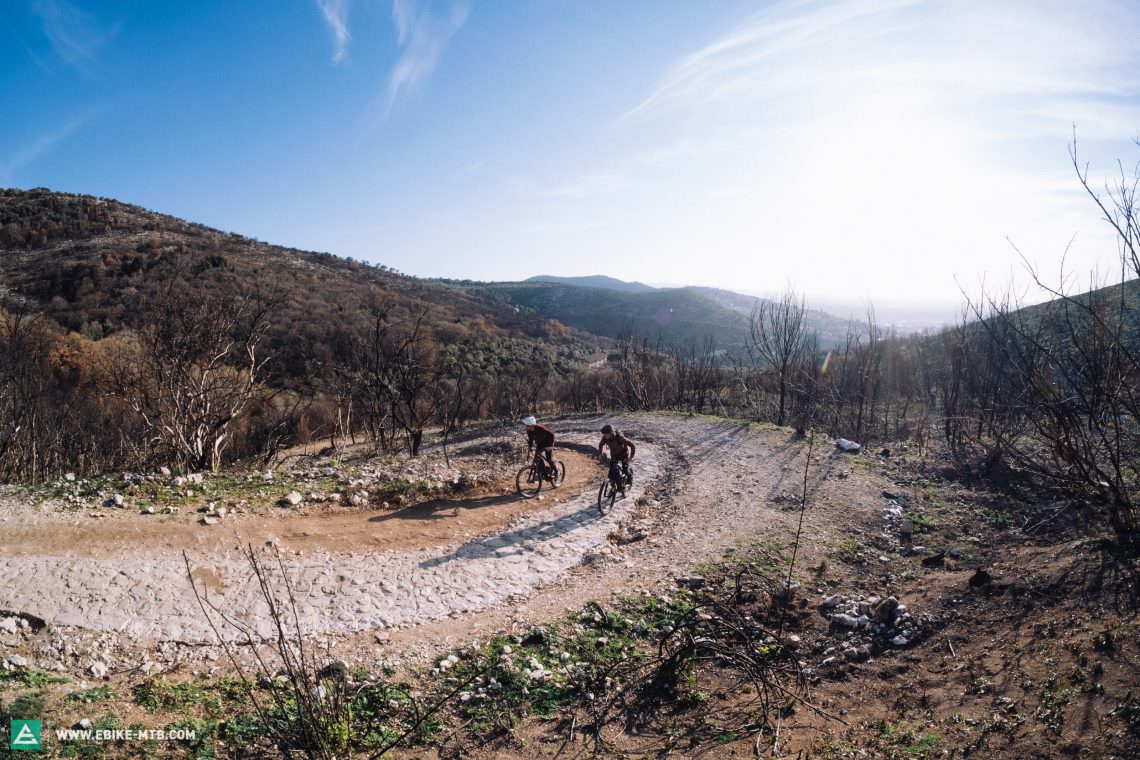
Fortunately, the Yamaha motors power us up the steep ramps. We self-shuttle up the first incline and soak up the views. The ground beneath us is scorched and we keep climbing, passing a number of horses out on a trek. The silhouette of the distant city gets even smaller and it feels like we’ve been transported to another world, but if we squint hard enough, we can make out some of the sights.
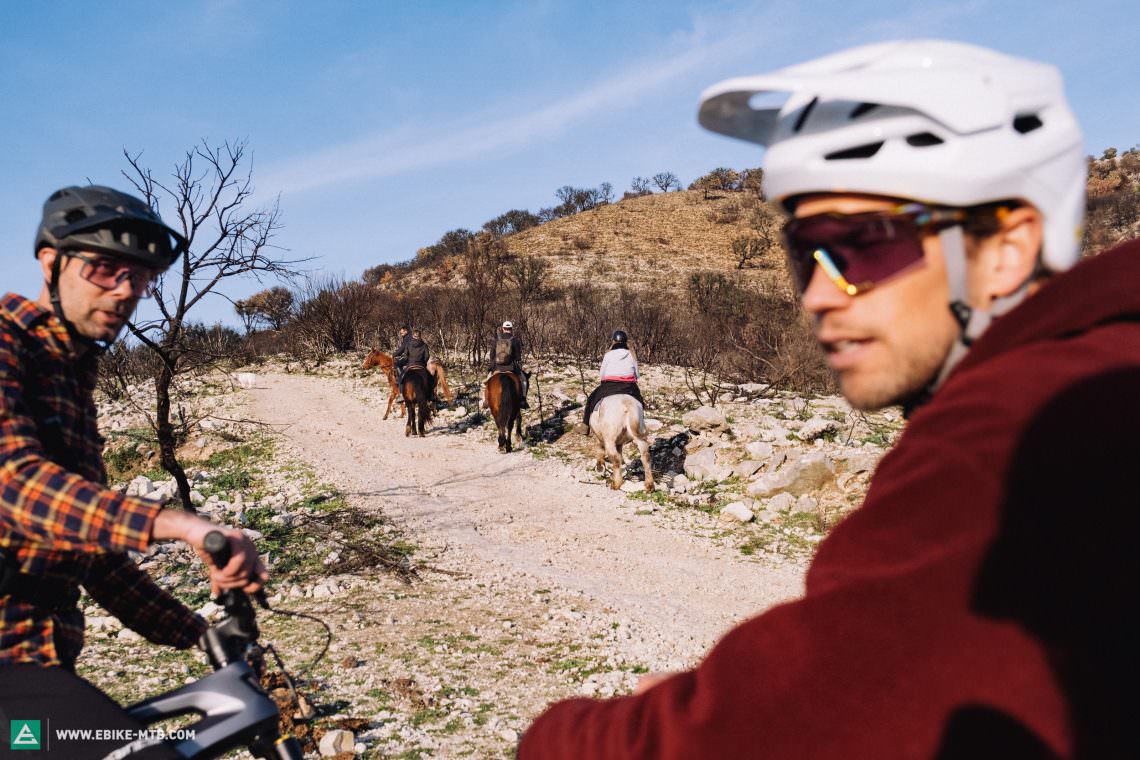
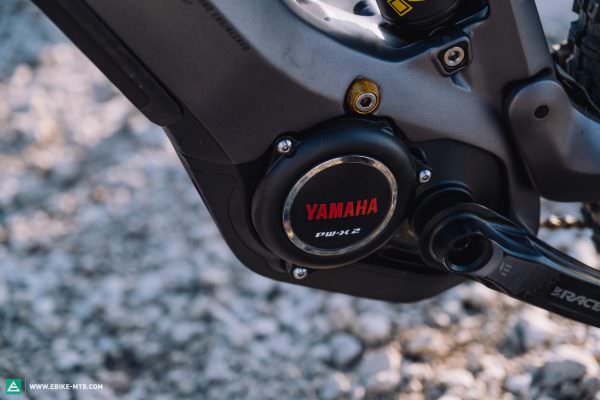
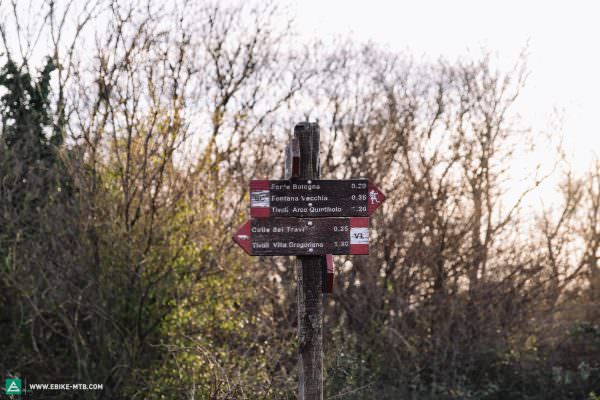

To the disbelief of the onlooking bulls, we’re almost at the summit and still completely uninformed as to what we’ll find there. We turn the bikes to drop into the descent and within metres we’re ready for the games to begin.
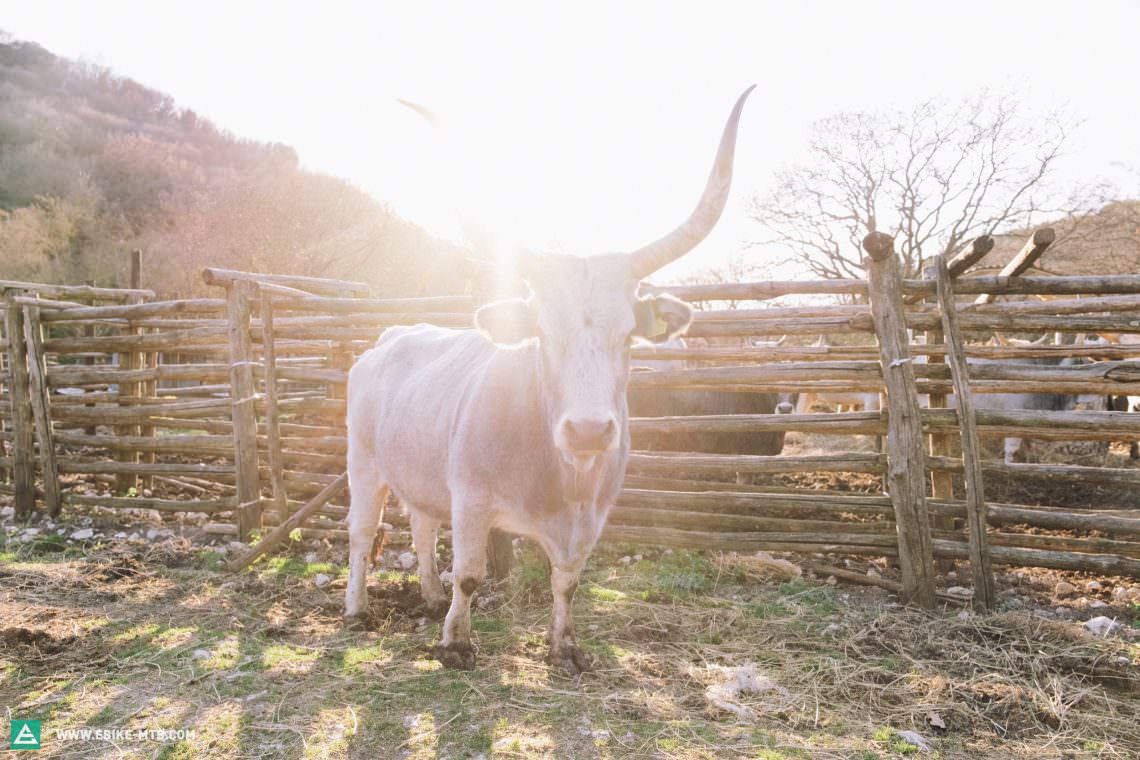
Our pedals scrape on rocks and at times we’re forced to dab a foot to stay upright. Knee pads wouldn’t be out of place here. We navigate chutes carved by water gullies to get through sections of the trail blocked by where the local limestone rock has blocked it. There’s not much flow in those sections. Alberto, who knows the trails like the back of his hand, finds it amusing as we struggle with the rubber in the dirt. We give it a whirl and after that short stint, the trail turns into a mellow singletrack down towards the valley. For skilled eMTB riders, we reckon this trail will be a riot, a quest that pitches adventure against awesome views. What else justifies a visit to Tivoli is its naturalness, totally without glitz and glamour. Passionate locals ride here – not tourists with wheelie cases – which makes it the perfect day trip. There are a few technical spots, so Tivoli isn’t ideal for first-timers.
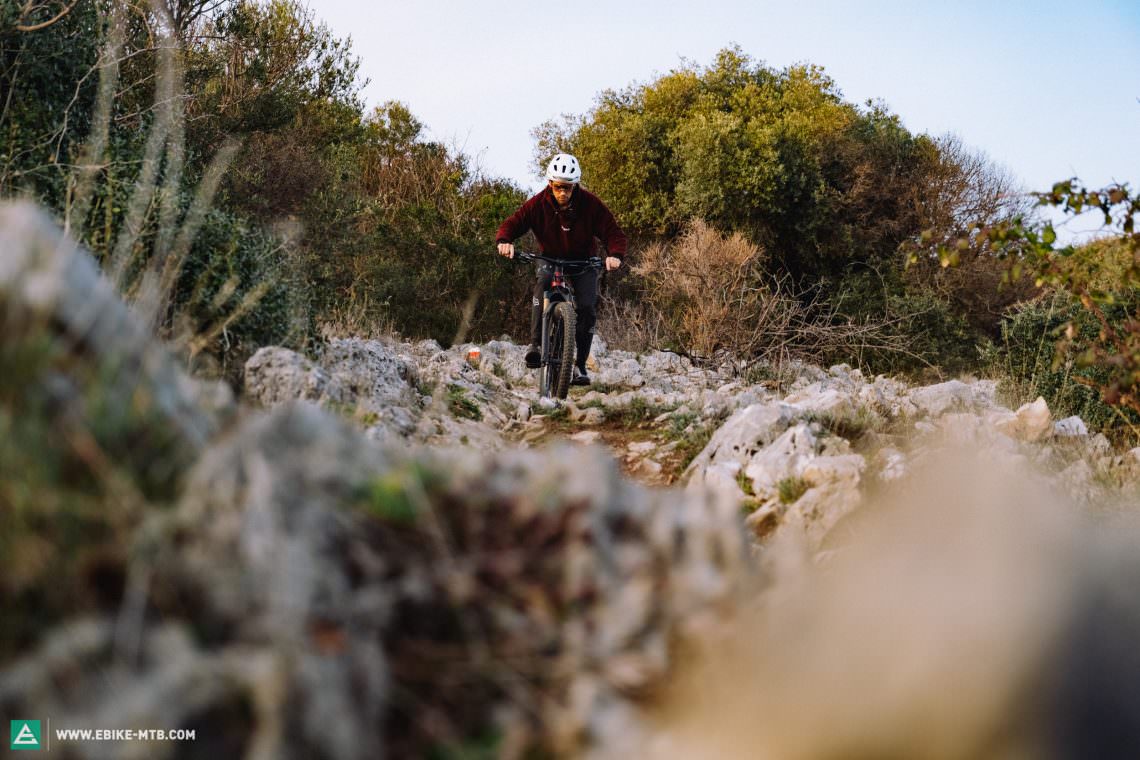
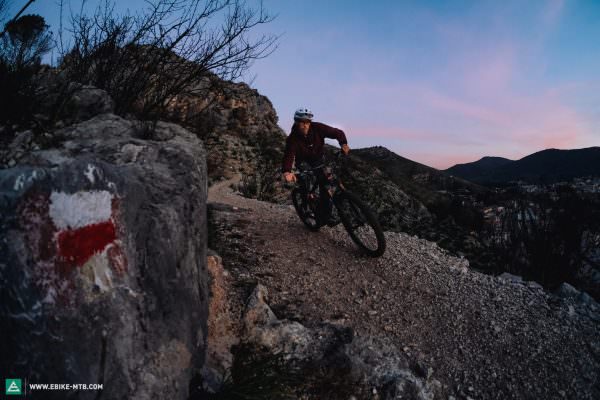
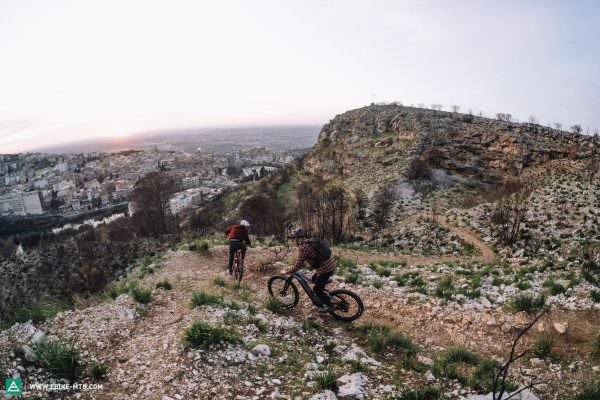
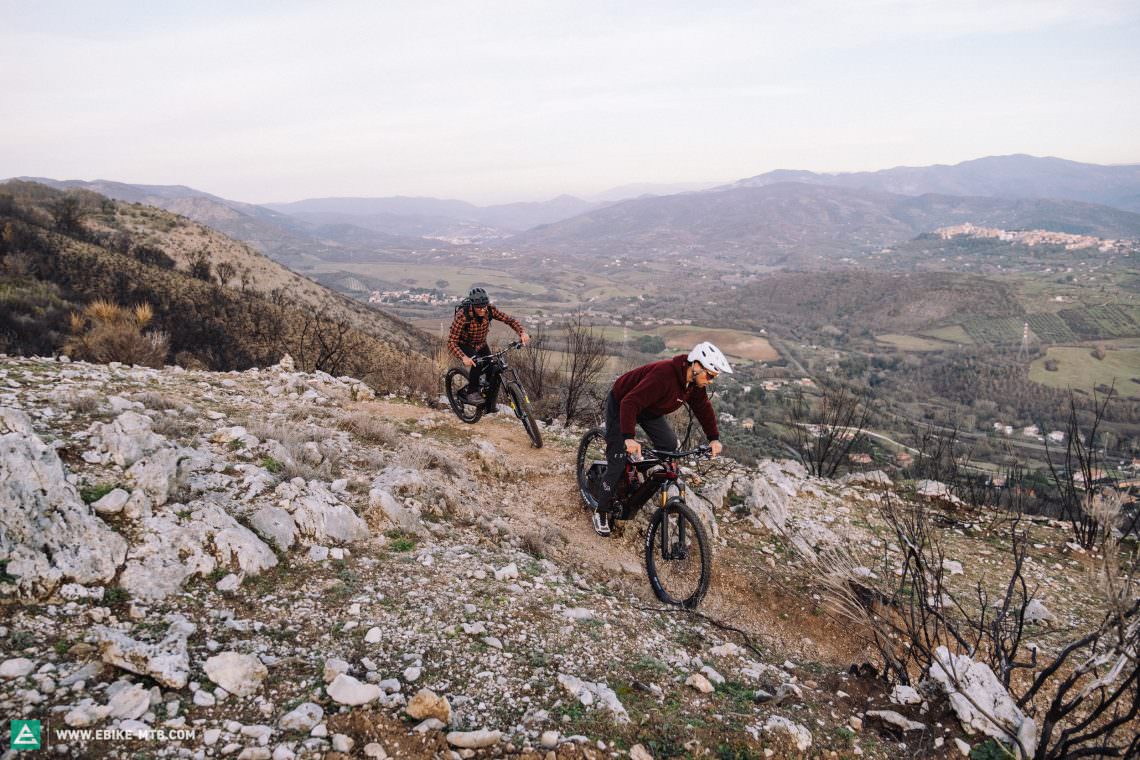
Rome still has the flow!
When we hit the trails in Formello, it’s a whole other ballgame: flowy, fast and fun in an area that’s less rocky, with trails that are built to be more like a rollercoaster. The local diggers have nailed it for beginners and experts alike. In terms of the town, it’s pretty sparse on culture and charm, but there’s an inconspicuous-looking restaurant with a large car park that appears to be the official unloading zone for the bike park here. Want to do some laps of Veio Bike Park? You bet. It’s just 40 minutes outside the town with quick climbs and rapid descents. We make tracks quickly, aware that the sun is threateningly low in the sky. We pedal up the climb in turbo mode for the quickest access to the good stuff, listening to nothing but the sound of our tyres crunching over the ground and the whirr of the motors. The city still feels a million miles away.
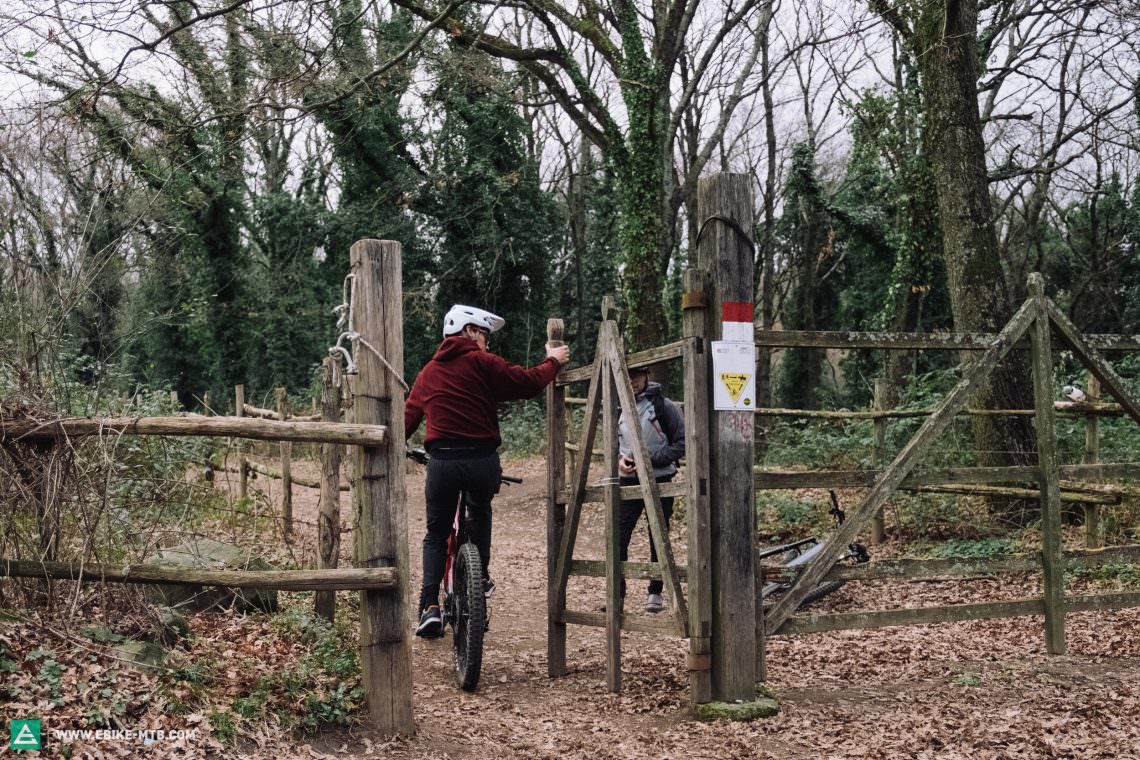
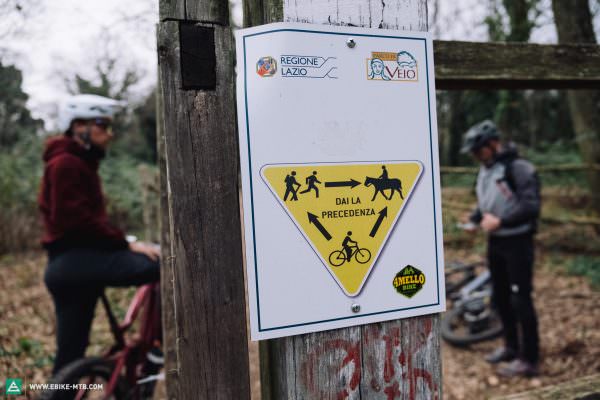
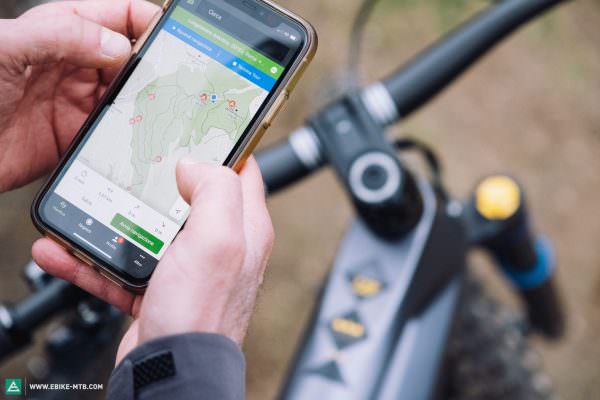

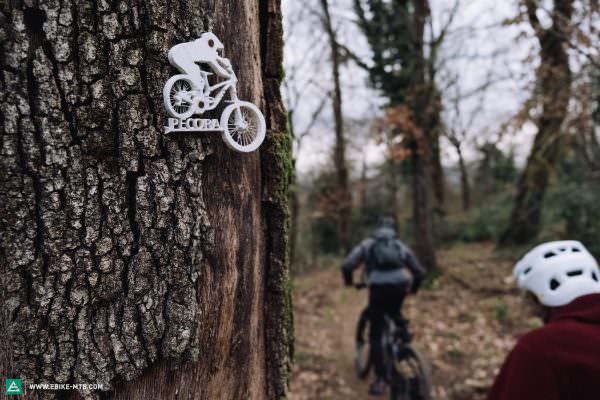
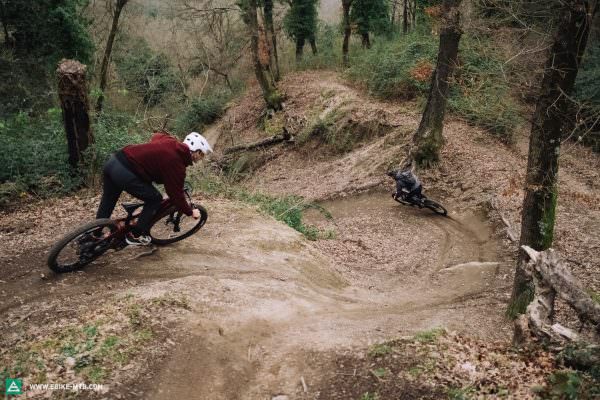
Top to bottom, the Veio Bike Park is quick. We shred down Pecora and Capra in quick succession, letting out whoops that echo through the woods. It’s addictive riding with beautifully made berms, first left, then right, then a kicker drop, and into the next berm. It’s the sort of bike park that satisfies every ability, without any of the hair-raising, can-you-keep-it-uprightness of Tivoli. If you’re after a reputable spot for flow and quick laps to get your heart racing, it’s worth putting this on your list.

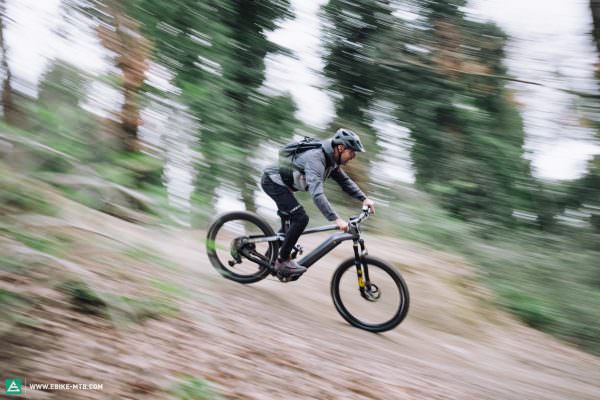
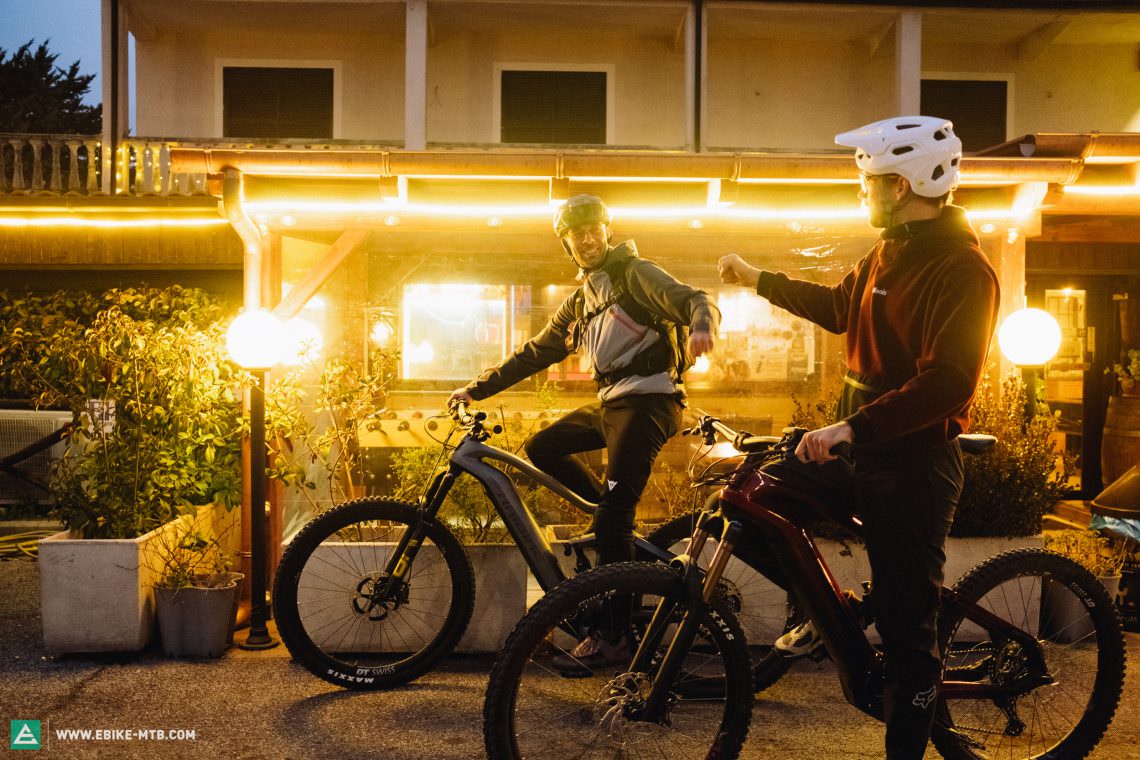
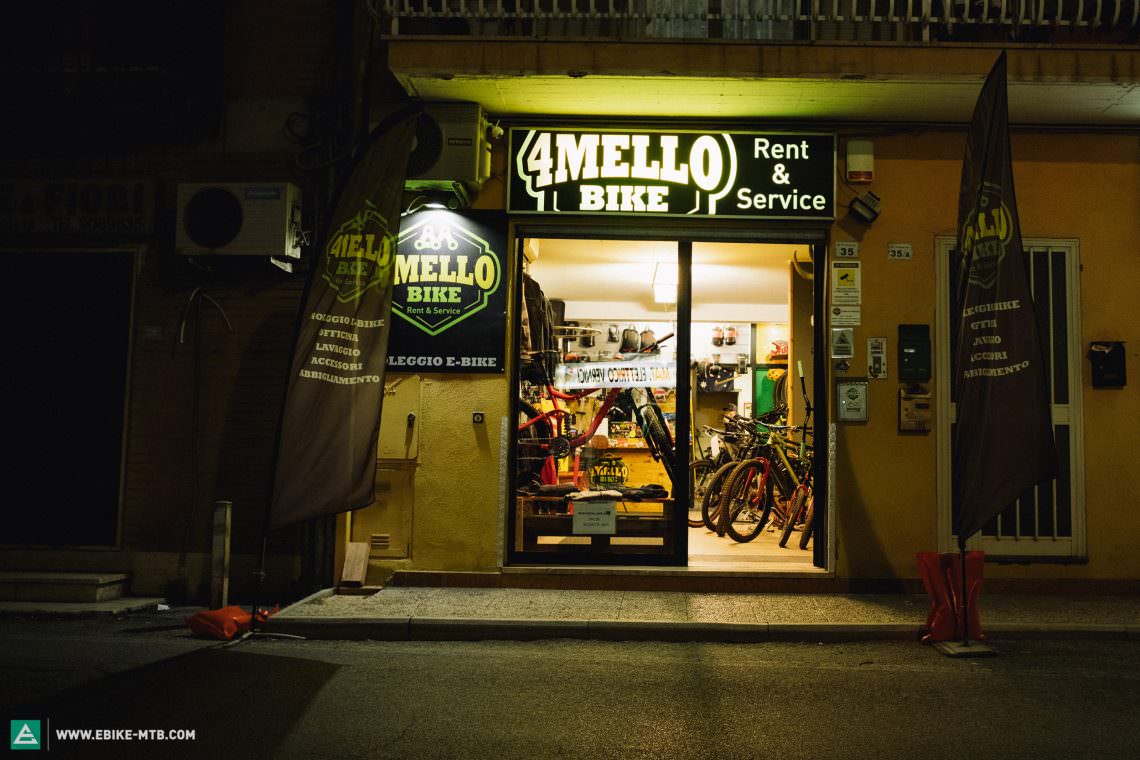
Want to ride in our traces? Here are the trails:
Tivoli:
Formello:
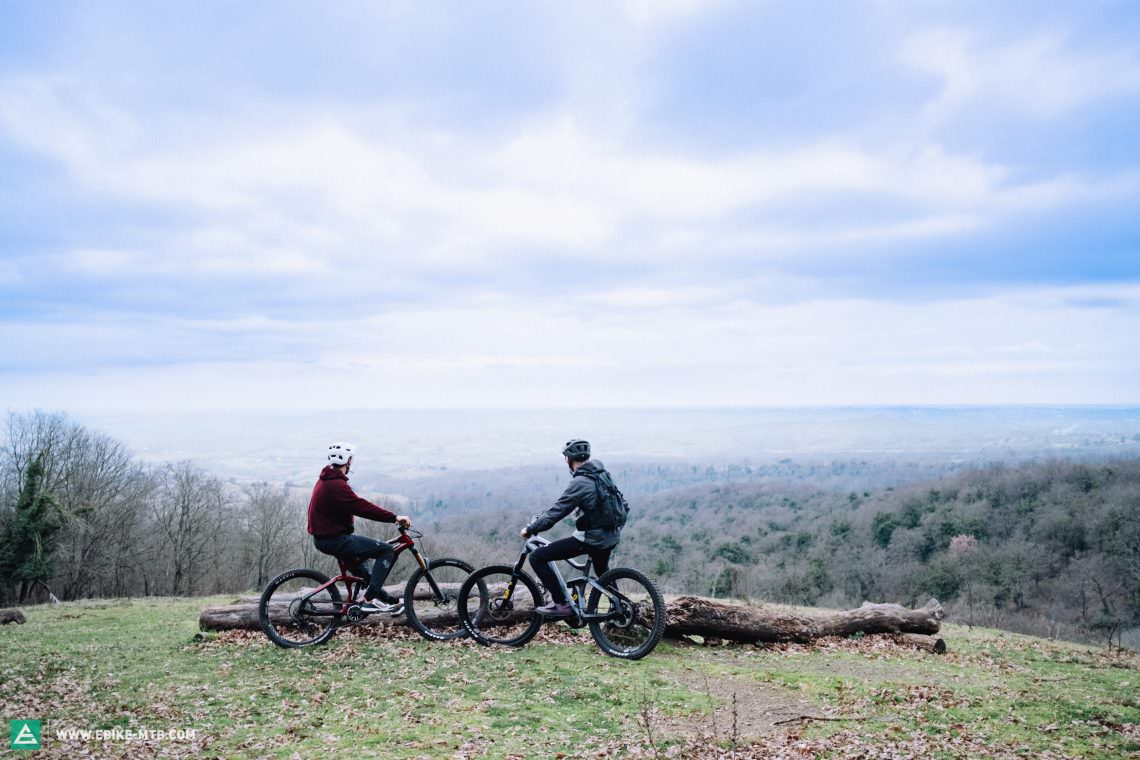
5. Escape Essentials – Cafés, bars, restaurants, dos and don’ts in Rome
Bike-Shops
Bikeroma EBIKE Rental & Tours
Where? Via Val Sassina 70/72, 00141 Rome
Web bikeroma.shop
BICIFICIO DINAMO
Where? Piazza della Marina 15, 00196 Roma RM
Web bicificiodinamo.com
4Mello Bike
Where? Via Nazario Sauro 35, 00060 Formello
Web 4mellobike.it/
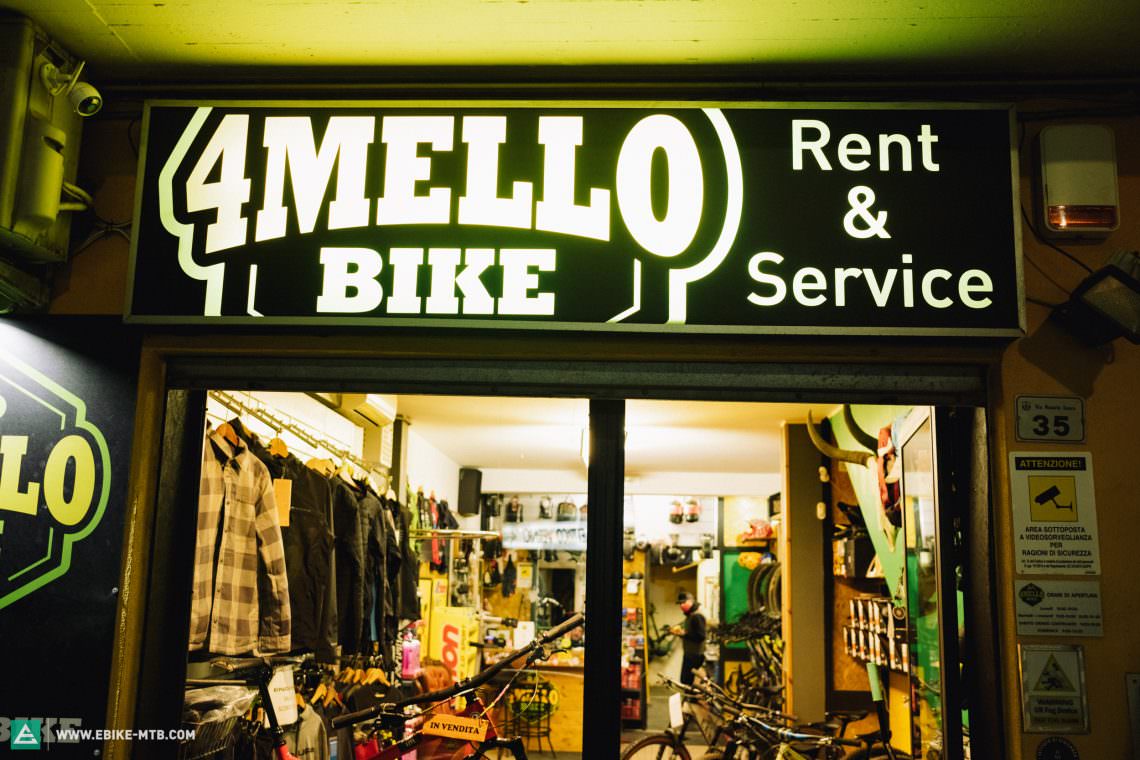
Where to sleep?
As you’ll be worn out from exploring the Eternal City or getting cramp in your calves from hot laps on the trails, you’re going to want somewhere welcoming to unwind. Here’s our edit of E-MOUNTAINBIKE approved residences to use as a base and retreat to in the evenings after more red wine and pasta.
Damaso
Where? Piazza della Cancelleria 62, 00186 Rom
Web hoteldamaso.it
The Hoxton, Rome
Where? Largo Benedetto Marcello 220, 00198 Roma
Web thehoxton.com
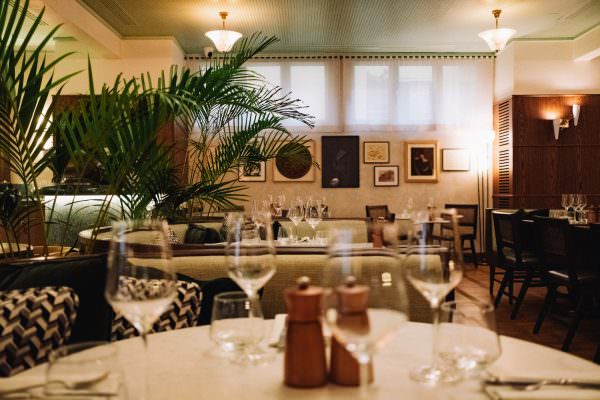
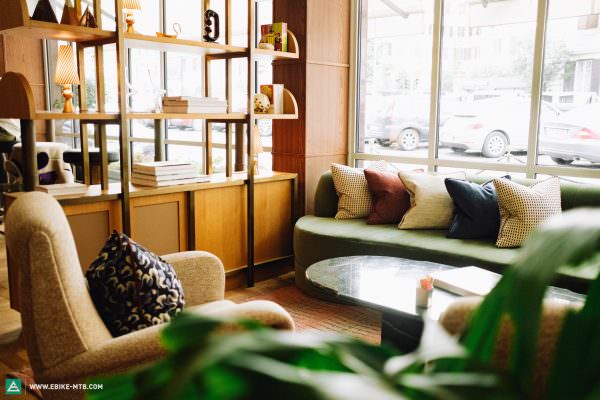
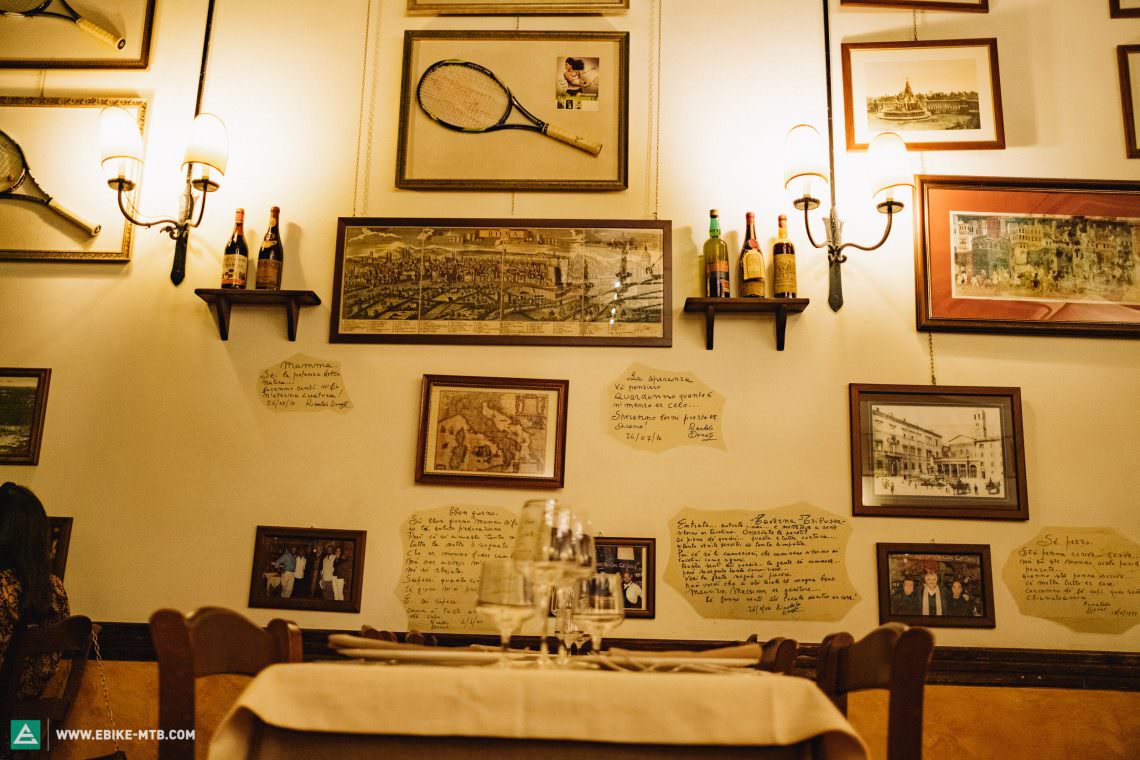
Where we ate!
Taverna Trilussa Trastevere
Where? Via del Politeama 23/25, 00153 Roma RM, Italien
Web tavernatrilussa.com
Tonnarello
Where? Via della Paglia 1/2/3, 00153 Roma RM, Italien
Web tonnarello.it
The Hoxton, Rome
Where? Largo Benedetto Marcello 220, 00198 Roma
Web thehoxton.com
Fra Diavolo Pizzeria
Where? Via Po 29a, 00198 Roma RM, Italien
Web fradiavolopizzeria.com
La Renella Forno Antico Trastevere (Pizza auf die Hand)
Where? Via del Moro 15, 00153 Roma RM, Italien
Web www.fradiavolopizzeria.com
L’Ape 50 (Tivoli)
Where? Via Ponte Gregoriano 5, 00019 Tivoli RM, Italien
Web lape50.eatbu.com
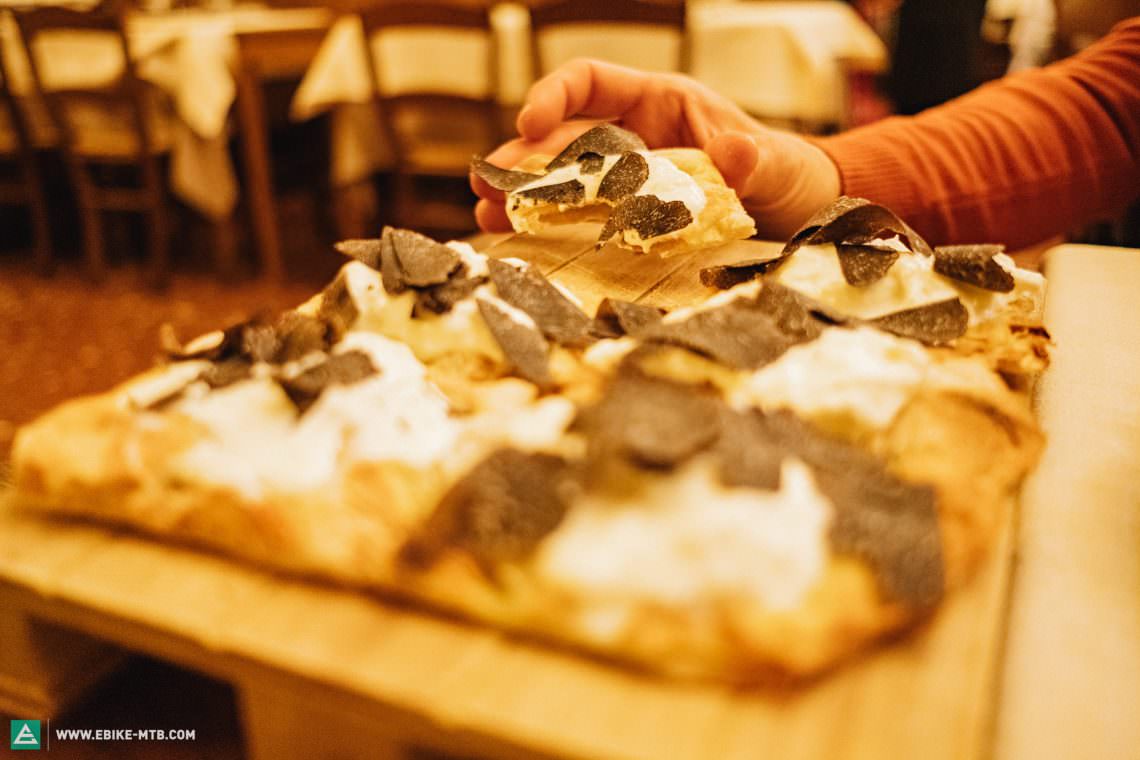
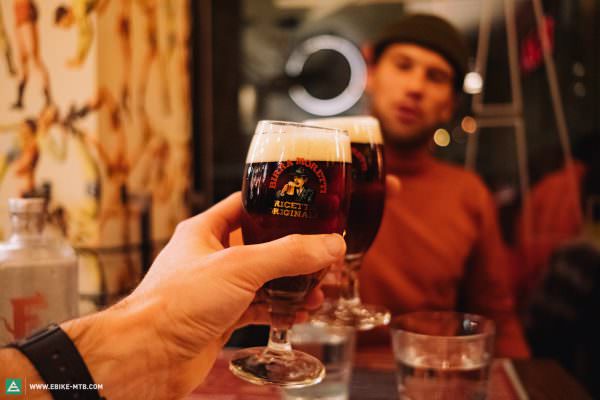
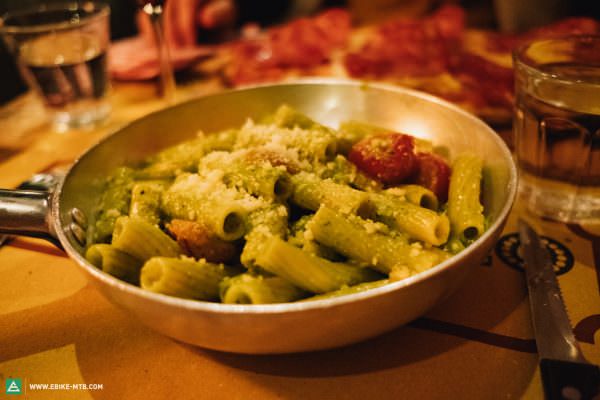
Where we enjoyed an Aperol Spritz!
Salotto42
Where? Piazza di Pietra, 42, 00186 Roma RM
Web salotto42.it
Pimm’S Good
Where? Via di Santa Dorotea, 8/9, 00100 Roma RM, Italien
Web www.pimmsgood.it
Jerry Thomas Speakeasy
Where? Vicolo Cellini, 30, 00186 Roma
Web thejerrythomasproject.it
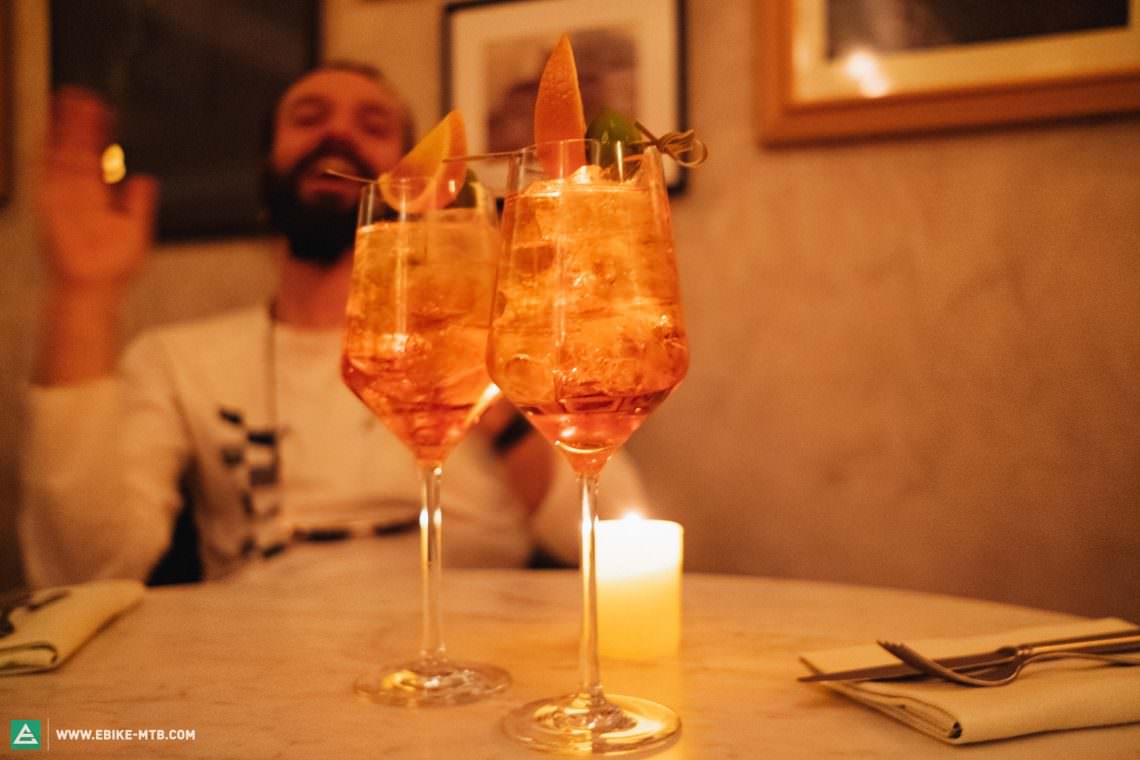
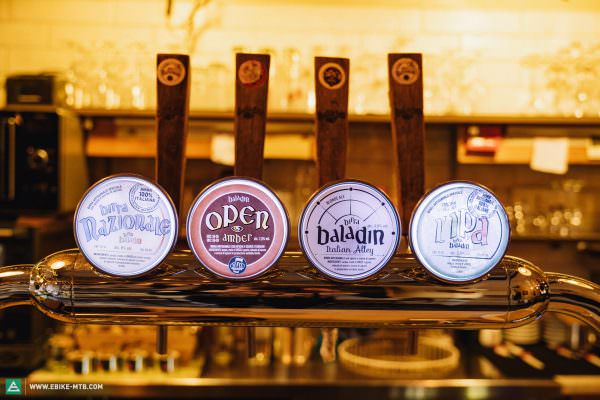
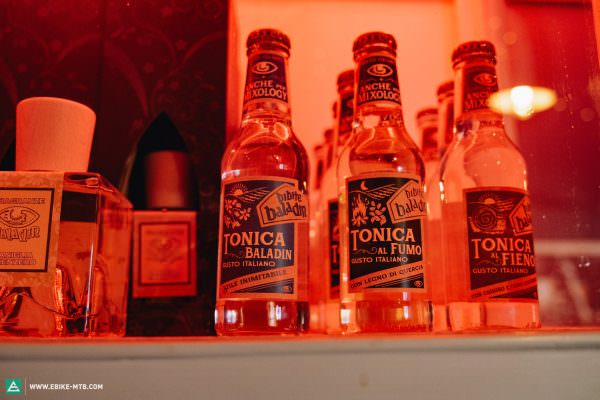
Dos
- Sightsee by bike, that’s mandatory
- Traditional taverns have earned their place in the Eternal City, respect them and seek out the best ones for food
- Take your bike bottle with you everywhere you go! Refill regularly from water fountains, which are supplied by those historical aqueducts. (Rome has enough issues with rubbish collection, don’t add to it)
- Eat pizza slices by hand
- Visit the Pantheon before the crowds
- Admire the Trevi Fountain in the evening
- Lay out a picnic rug for a doze in the Villa Borghese Park
- Stroll through the Trastevere district on the weekend
- Lock your bike (obviously)
- Book a table in advance for dinner
- Flirt with the serving staff
- Shred the trails in Tivoli and at the Veio Bike Park
- Involve your hands in everything you’re saying, gestures are everything
- Ride along the River Tiber

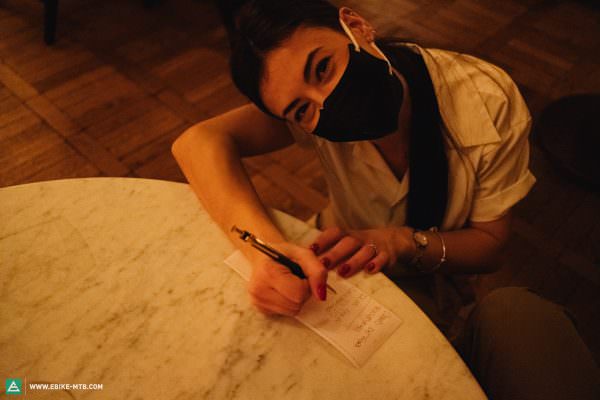

Dont’s
- Lend Caesar your bike
- Book a city guide with a street-seller
- Overindulge in pizza and/or pasta
- Order a cappuccino (we were not impressed, not once)
- Leave your bike unattended
- Lean your bike against a wall (we have never had so many run-ins with the police about this)
- Think about using a car
- Be tempted by a restaurant offering a ‘family price’
- Whip out your camera while on a tour. People take thousands of photos of ruins, but is anyone actually seeing them?
- Expect hip cafés (a rarity)
- Sleep in Trastevere on the weekends – it’s a big nightlife zone and Italian windows are notoriously un-soundproof



Italiano for beginners
It’s a completely phonetic language, so once you’ve got the hang of some sounds, you can essentially read any word in front of you and sound like a native. Don’t be afraid to go all-in with emphasis and gestures – the more pronounced, the better.
C – When a ‘c’ is followed by an ‘e’ or an ‘i’, pronounce it like ‘ch’ in ‘cheese’. When it’s a ‘c’ followed by an ‘h’ or an ‘o’ or ‘a’, it’s more like the ‘c’ in ‘cut’.
Example: come stai = How are you? Cane / Dog, Cioccolato / Chocolate
When a ‘g’ is followed by certain vowels, pronounce it like the ‘j’ in ‘jumble’.
Example: gelato = „dschelato” ( ice cream)
GL:
It’s like the ‘lli’ in million.
Example: aglio e olio = „aljo e olio“ (garlic and olive oil)
h:
Double consonants, like ‘cc’ or ‘zz’. Emphasise these. Make a distinction in your pronunciation between the two.
Yes – sì („si“)
Non – nò („no“)
Hi /Tschüss – ciao („tschau“)
Good morning/hello – Buongiorno! („Bondschorno“)
Good eveningGuten Abend – Buonasera! („Bonasera“)
Have a good weekend – Buon fine settimana! („buon fine settimana“)
How are you? – Come stai? („kome s-tai“)
I’m well, thanks – Sto bene. („sto bene“)
Please – per favore („per fawore“)
Thanks – grazie („grazi-e“)
Sorry! – Scusa! („skusa“)
My name is… – Mi chiamo/a… („me kiamo/a“)
Cheers! – Salute! („salute“)
Enjoy your meal! – Buon appetito! („Buon apetitto“)
How much does it cost? – Quanto costa? („kuanto kosta“)
The bill, please! – Il conto, per favore! („il konto, per fawore“)
C’mon! – dai!
I (don’t) understand – (Non) capisco (non)(capisko)
6. Escape faster – Our electric whips for Rome, in detail
Haibike AllMtn SE
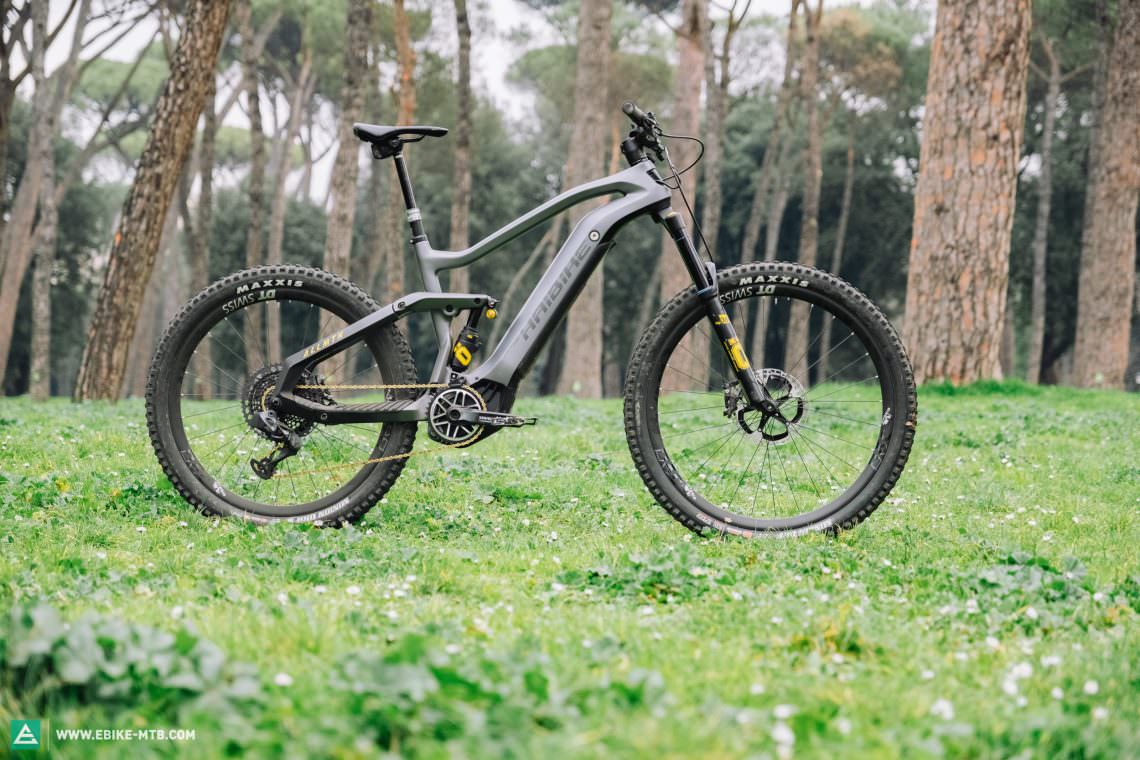
22.58 kg in size L | € 10,000 | Manufacturer’s website
This jaw-dropping, tenth-anniversary edition bike for Haibike’s ePerformance sector would certainly have been Caesar’s whip of choice. With a beefy full carbon frame that’s specced from front to rear with hand-selected components, it’s the Öhlins suspension and the high-tech SRAM XX1 Eagle AXS groupset that captured our attention most. But the Haibike AllMtn SE is more than just the sum of its parts: it’s the pinnacle of a decade of pioneering research, development and innovation into ebikes that have led to this piece of beauty. Running on the powerful, highly responsive Yamaha PW-X2 motor and delivering the ultimate traction, it climbs like a well-tamed beast and once you turn for the downhill, it shines with style and capability, so you aren’t short of thrills.
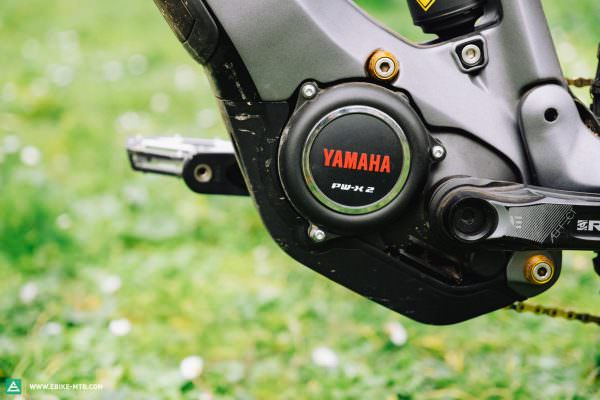
10 years in the world of ebikes + 100 years in the motorsport world thanks to Yamaha and Öhlins

10 years of ePerformance and still first on the dancefloor. The Haibike AllMtn SE is ready to rock!
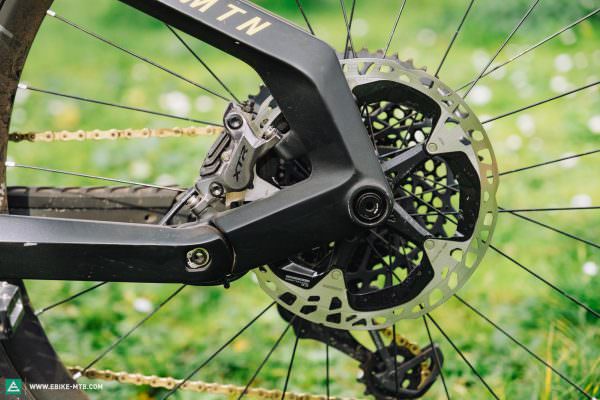
Haibike have integrated the Shimano XTR four-piston brakes into the distinctive dropouts

A City Escape on the Haibike AllMtn SE brings a whole new meaning to being unchained. This eye-catching gold chain won’t be holding you back – in fact, it’ll give you extra style points.
The Haibike AllMtn 12

24.3 kg in size L | € 6,499 | Manufacturer’s website
For Tivoli’s rock gardens and the flowy trails in Veio Bike Park, we opted for the Haibike AllMtn 12, knowing that the raw power of the Yamaha PW-X2 motor with its 600 Wh battery would rocket up the steepest climbs in Tivoli, so we would reach the trails without breaking a sweat. On descents, we were digging the eMTB’s FOX 38 Factory fork and RockShox Super Deluxe Select rear shock, both keeping us glued to the ground in a good way with 160 mm travel each. The high front end and serious stopping power from the Shimano XT four-piston brakes when you drop the anchor have all the credentials to instill confidence in newer riders.

A mullet wheelset and 160 m front and rear suspension provide a worthy trail performance and enough spiciness to get advanced riders hot under their collar too
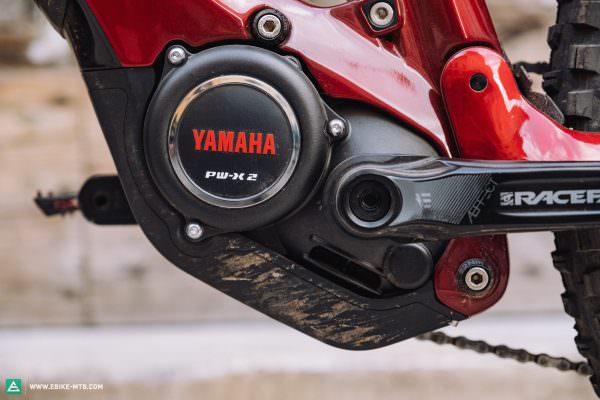
Given the raw power of the Yamaha PW-X2 motor, you can soar up any climb – and probably even ride up the Spanish Steps (just watch out for the police)
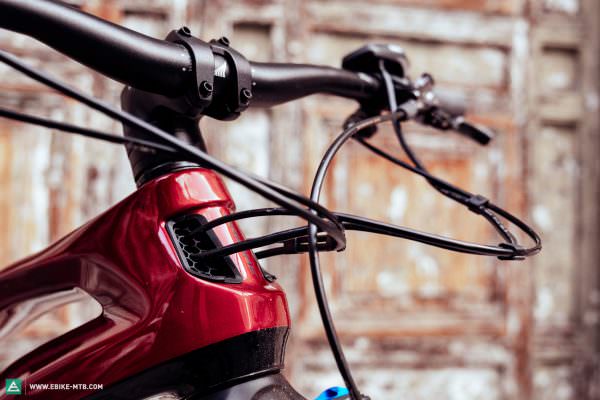
Who doesn’t appreciate the good looks of absent cables thanks to Haibike’s recognisable cooler grill?
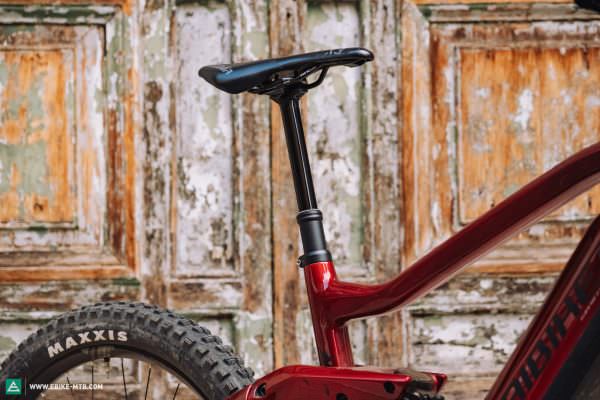
The deep-red metallic finish on the AllMtn 12 would fit in well on a Fendi catwalk
Fancy a tour through Barcelona, Zurich, Vienna, Lisbon, Frankfurt or Berlin? You can find our previous E-MOUNTAINBIKE City Escapes and lots of insider tips and insights into each of the cities we’ve visited here.
Did you enjoy this article? If so, we would be stoked if you decide to support us with a monthly contribution. By becoming a supporter of E-MOUNTAINBIKE, you will help secure a sustainable future for high-quality cycling journalism. Click here to learn more.
Words: Julian Lemme Photos: Julian Lemme / Robin Schmitt









